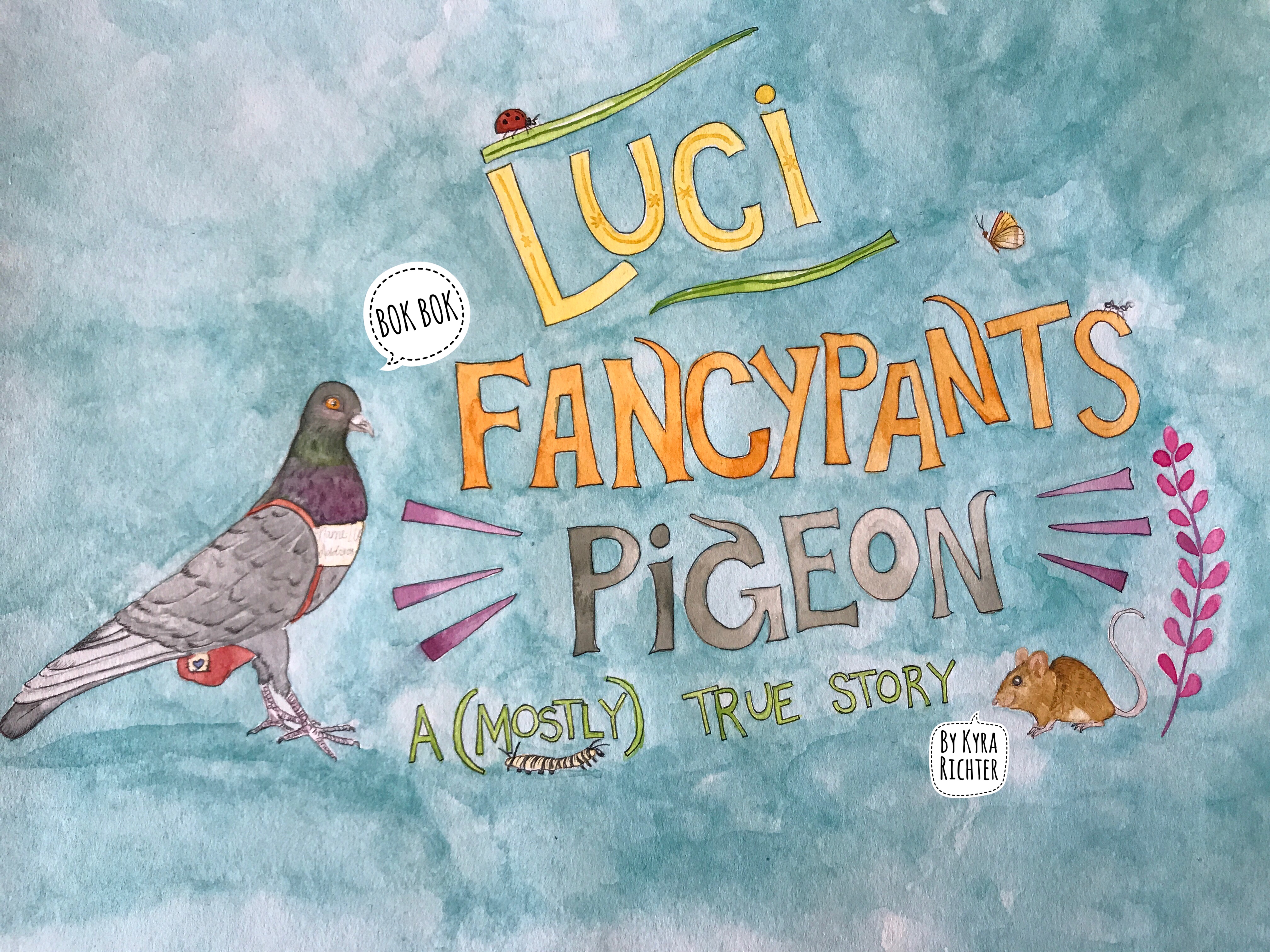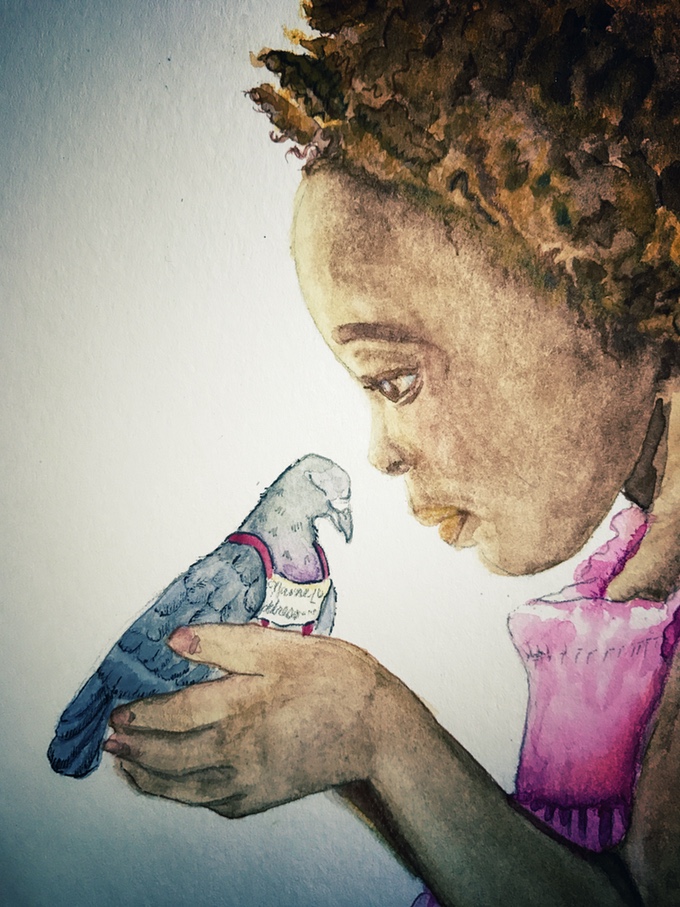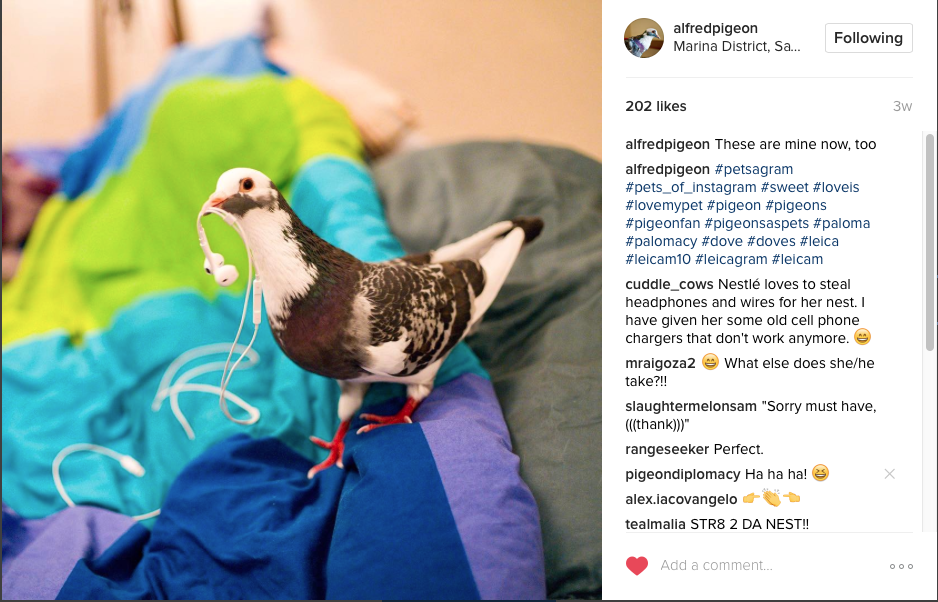June 5, 2017
by Elizabeth
Comments Off on Bird Needs Help! What Do I Do? How Do I Catch?
May 22, 2017
by Elizabeth
Comments Off on Self-Rescuing Pigeon Sochi Selected for Photo Contest!
Self-Rescuing Pigeon Sochi Selected for Photo Contest!
Congratulations to Super* Sochi the self-rescuing King pigeon and his rescuer and photographer Patti Delaney! This beautiful photo, taken while Sochi was making a very special new friend at an outreach event earlier this year, has made it into Global Giving’s 2017 Photo Contest as a semi-finalist! Please support us with your vote and help us compete for the $1000 prize and lots of extra publicity! Contest voting starts now and goes through Friday, May 26th at 9 AM PT. Only one vote per person and email verification is required. (*Self-rescuing pigeons who, like Sochi, inspire the rescue and adoption of other pigeons are promoted to the status of Super!)
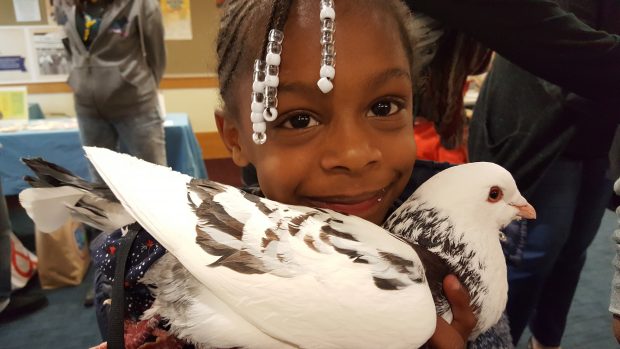
Sochi is an expert ambassador who loves making new friends & inspiring compassion. Photo by Patti Delaney
Sochi’s Story
Guest Post by Patti Delaney
On February 18, 2014, I arrived home from work to find my husband sitting on the planter box in the front yard talking to a pigeon. He said it wouldn’t leave. I suspected something was wrong with it, injured or sick. I threw my sweater over it and put it in a cat carrier. I sent a picture to Elizabeth Young at Palomacy, asking “What do I have?” “Domestic, unreleasable King pigeon bred for meat, squab”, she said.
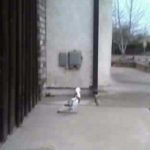
In need of help…
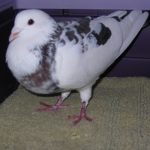
Safe
I brought him to see her at the next outreach and confirmed he bird was a big, male King pigeon in great shape considering he had been out alone and unprotected.
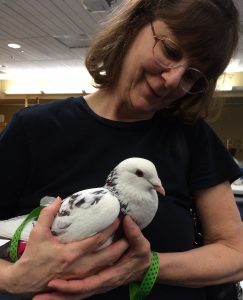
Patti & Sochi
The Winter Olympics were on and the landscape of the Olympics in Sochi resembled the coloring of this pigeon—he was named Sochi.
Sochi stayed indoors in a cat condo until a used aviary could be assembled and refurbished. We paired him up with a pigeon we thought was female, Pearl, but who turned out to be male too. This paring was not a good match. Eventually two rescued female domestic pigeons were introduced to Sochi and Pearl. The aviary was too small for all four pigeons. Sochi and his chosen girl, Amica, stayed; Pearl and Xena left to be fostered.
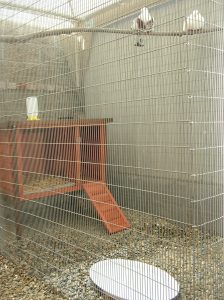
Sochi & Pearl
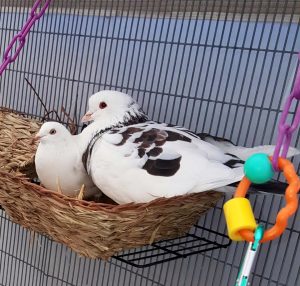
Amica & Pearl
Last July, another self-rescuing domstic pigeon, dyed, starving and near death, landed on a relative’s window sill. After nursing her back to life and when she was strong enough, she was placed in a cage within the aviary. We named her Jo Jo. Jo Jo loved Sochi, but Amica refused to share Sochi. This was not a good situation.
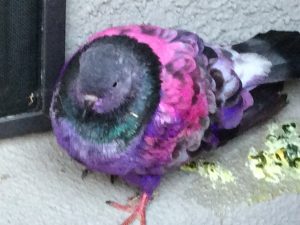
Jo Jo the day she was rescued

Jo Jo recovering
Our solution was to build a big, beautiful 8’ x 10’ aviary. With the help of Palomacy, we found a mate for Jo Jo and brought back Pearl and Xena to be adopted. They are all home. There is no bullying from Sochi. In fact, he is a healthy, happy pigeon with Amica and all his flock mates. (Turns out it is easier to care for a flock of pigeons than just a couple!) Periodically he goes to outreach events. He does a great job and thoroughly enjoys the attention.

Jo Jo, fully recovered & married to Domino

Happy flock in the aviary home Sochi inspired
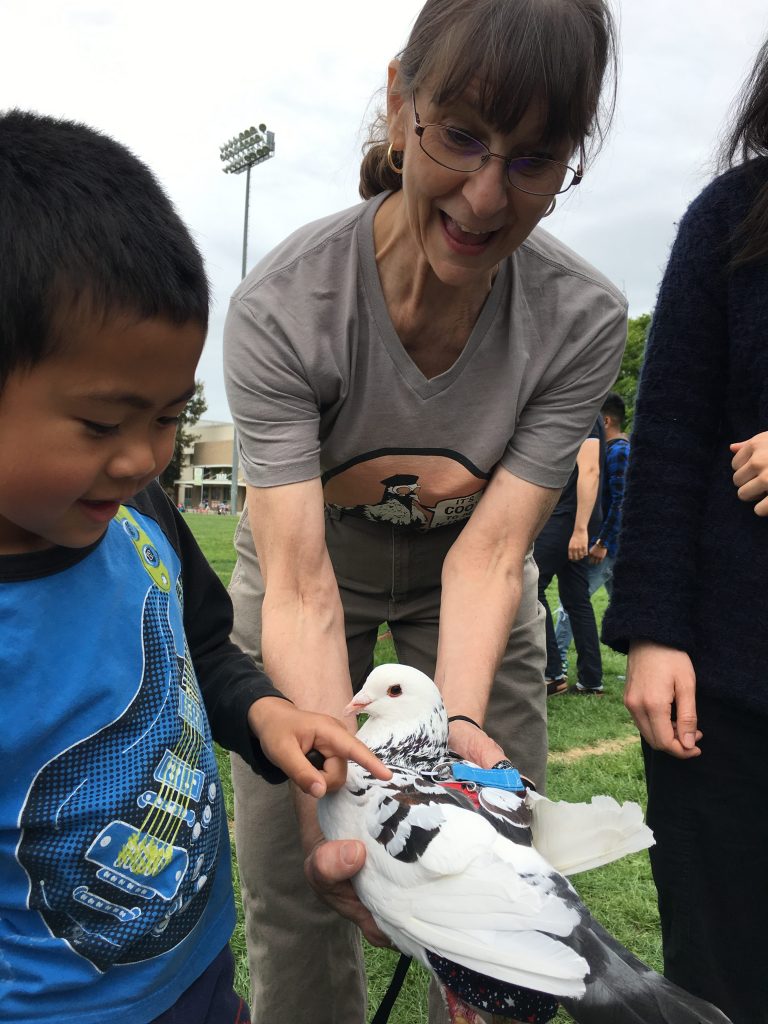
Patti & Sochi winning new friends for pigeons
Don’t forget to vote for Super Sochi and please share with your friends!
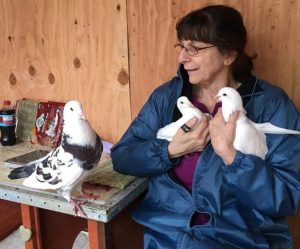 Patti Delaney is a long-time bird lover. In 1992, she met and purchased a 5-year old Umbrella Cockatoo, Lacy. Wanting to learn more about bird care, she became a member of the Capitol City Bird Society. In the Sacramento community, she was a paid guest speaker with Lacy. When Lacy died unexpectedly in 2009, she found and adopted an Umbrella Cockatoo, Georgi, from the bird rescue, Mickaboo. This is when she met Elizabeth Young with Palomacy (previously MickaCoo) and became knowledgeable and passionate about stopping the exploitation of domestic pigeons and doves.
Patti Delaney is a long-time bird lover. In 1992, she met and purchased a 5-year old Umbrella Cockatoo, Lacy. Wanting to learn more about bird care, she became a member of the Capitol City Bird Society. In the Sacramento community, she was a paid guest speaker with Lacy. When Lacy died unexpectedly in 2009, she found and adopted an Umbrella Cockatoo, Georgi, from the bird rescue, Mickaboo. This is when she met Elizabeth Young with Palomacy (previously MickaCoo) and became knowledgeable and passionate about stopping the exploitation of domestic pigeons and doves.
May 22, 2017
by Elizabeth
Comments Off on Luci Fancypants Pigeon; a Story for Children of All Ages
Luci Fancypants Pigeon; a Story for Children of All Ages
Guest Post by Kyra Richter

Luci
If there are two things that define me, it is my love of nature and my love of illustration. I have my mother to thank for inciting that passion for all living things. Growing up, my mother would always take time to go exploring with me. She would point out all the little creatures and tell me stories about their tiny but busy and important lives. To this day, I always step over an ant line or let a beetle cross the sidewalk. My mother would tell me they had places to go, other bugs to see and important roles to play in nature.
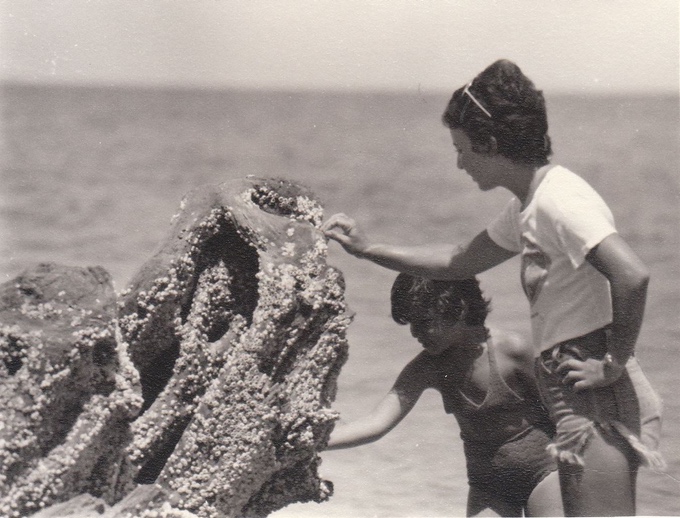
Me and my mom.
Later, as I fell in love with art, and began illustrating, she always encouraged me by saying “you need to make a book!” But we often think moms just say these things because they only have eyes for their children. As time passed, more and more people would encourage me to illustrate children’s books. I just didn’t have the right story. Well, the character and the story finally came the day I met Luci.
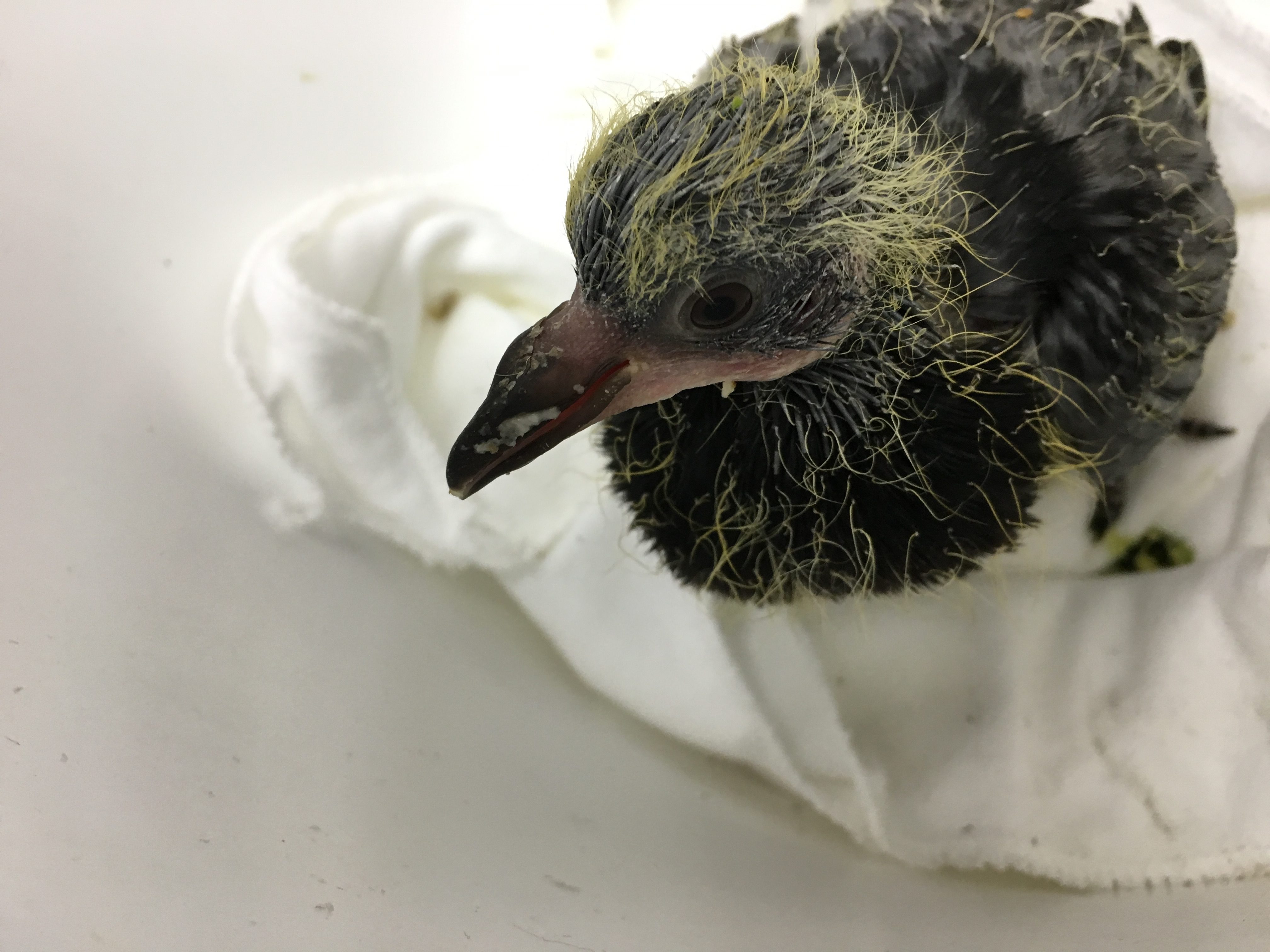
Baby Luci
A year ago, I arrived at work to find someone had left a bucket on my desk. Inside it was a baby pigeon. I work in the environmental department of a power plant, so I guess they figured I’d know what to do. I had no idea what to do. I had never interacted with a bird before, much less a pigeon. But here was this little face looking at me with no fear and absolute trust. Thank goodness for Google, who let me to Palomacy; and Youtube where I watched videos of people feeding squabs! I learned quickly and little Luci was a good teacher too. All my intentions of rearing her to return to freedom failed as Luci very quickly took to us (me and my husband) as his new parents. We did our best to give Luci as much freedom as (safely) possible. Part of having a free roaming bird at home meant we had to locate and purchase little “pigeon pants” so Luci would not make messes all over the place. One day I was at the grocery store when I got a frightened call from my husband who said that Luci had gotten out an open window- while wearing pants. All I could picture was a pigeon landing on a wire with other wild pigeons and being mercilessly teased beacause: pants! It’s comical but we were very worried. This was for naught as Luci came back within the hour. We were all very lucky and learned our lesson. Luci had changed our opinion about those plain gray birds people often call “rats with wings”. Luci is intelligent, has a very unique personality, and is very playful and loving. Caring for one rescue quickly turned into fostering and caring for more pigeons, mostly so Luci would not be alone (He now actually has a wife- Stella- another hand raised rescue).
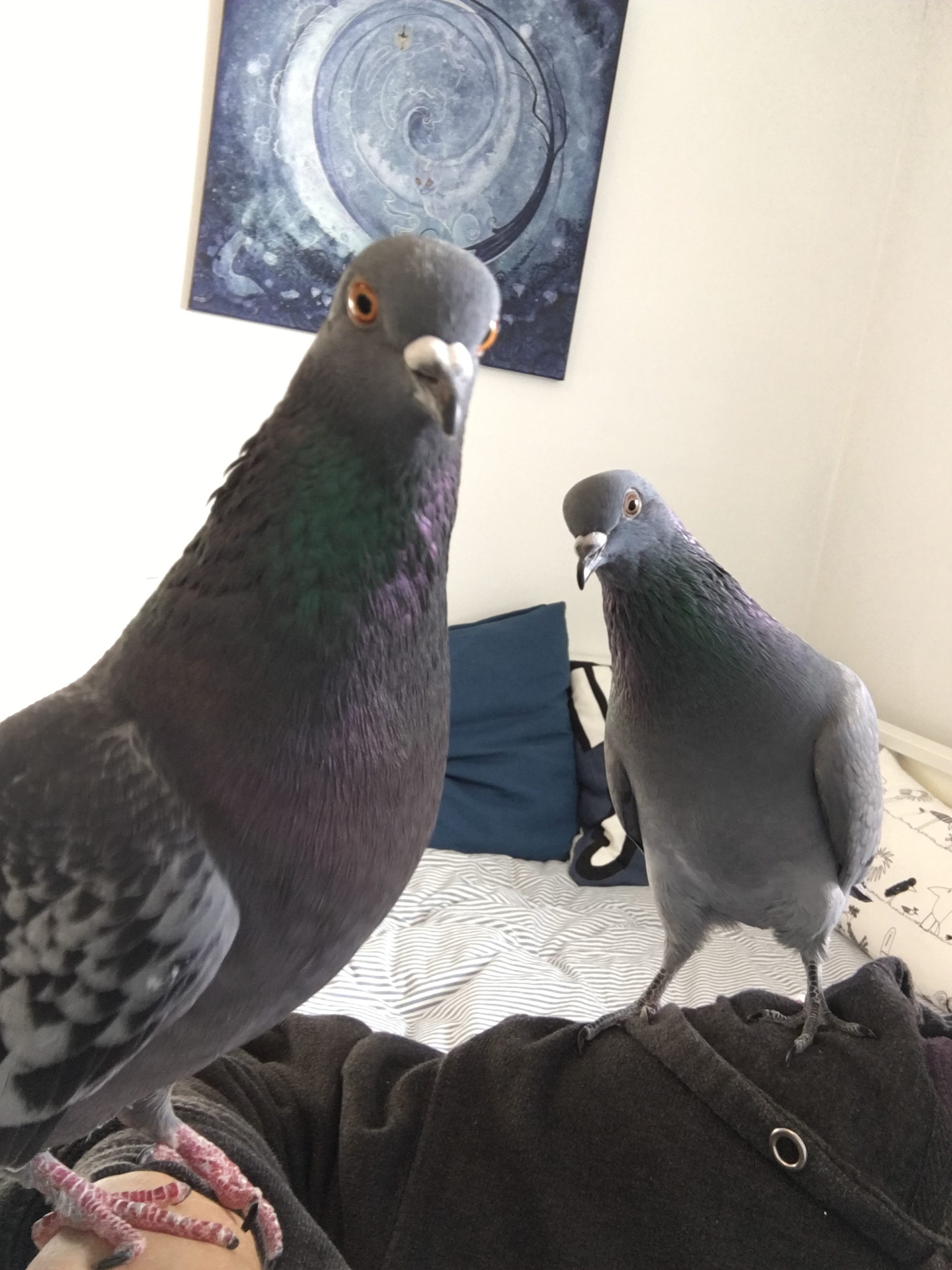
Luci & Stella
Here was my story at last! In addition, I was inspired by how beautiful pigeons are, once you take a moment to look at them you can’t take your eyes off them. So I started to draw them, and as I did so the story fully developed. This story has been lovingly illustrated in watercolor and ink under the careful supervision of Luci and Stella (you may have noticed that Luci is a “he” and not a “she”, something which took us some time to figure out and hence the odd spelling of his name). In this story, I hope to share the wonder and beauty of the smallest and plainest things. I hope children will be interested in the adventures they can have in their own back yard, observing ants, busy bees and butterflies, and see the joy that can be had from the simplest friendship- be it with a bird or with that one kid who does not look like the rest. Ultimately, that we are all unique and special and friendship can be found if only we are open to it.

Luci
Publishers tend to not be interested in publishing total unknowns. It is easier to self-publish. Did you know Beatrix Potter self-published the first edition of Peter Rabbit? I decided to self-publish, but in order to do this I need to crowdfund. So I began a Kickstarter campaign to help me collect the funds necessary to publish this childrens book.
With your pledge, I will be able to publish this book as an 11″ X 8.5″ hardbound book with a dust jacket and coated matte paper so that the 24 pages of illustrations can look their best. The book will be competitively priced and once this is up and running and 10% of profits will go to Palomacy, who provided me with the guidance I needed to be able to raise three healthy and happy pigeons, and successfully rehabilitate four others this past year (see my endorsement on Great Nonprofits).
The pledges also come with little extras, like signed 8″ X 8″ high quality prints of my watercolors, thank you cards illustrated by me, and even original illustrations from the book (that will be hard to part with!). A limited number will also receive an original watercolor pigeon portrait (mine, or yours if you have a pigeon you want me to paint a portrait of)! Should I be fortunate enough to overfund the project, I’d print more books but also be able to improve the rewards (like a T-shirt or baby onsie, for which I have designs!).
As many of you know, shipping across the Atlantic or, pretty much anywhere outside of the US is costly, and I aim to ensure you get a pristine book. Packaging and shipping will be part of the experience of getting a quality product. I have estimated approximately 4% for changes in pricing (I have my estimates but shipping costs could change) or, given that this is my first time, any errors in my estimation of costs. As mentioned above, at this point in time, any profits will be donated to Palomacy.
Please visit the Kickstarter Campaign for details on pledges, rewards, and an explanation of risks and challenges and how crowdfunding campaigns work.
I am so delighted with this project, and loving every second of this experience. I believe the story, as simple as it may seem, has a lot to impart to children. I already began layout for more stories. It is my intention that this is the beginning of a new path for me: illustrating stories and helping to draw attention to these most lovely and special birds. As an environmental manager, I have lived the frustration of how some birds are protected but the pigeon, which is not (and often considered a pest) suffers all the indignities. Their history is so unique, and long, and amazing. Their loyalty and love is an honor to witness. And they may seem plain and grey but they are truly beautiful creatures. My life will never be the same thanks to Luci. This is the least I can do.

Luci & Stella
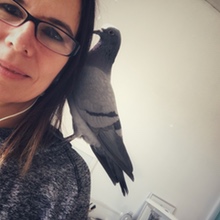 I work at a nuclear power plant as an environmental supervisor. Before that I was a commercial diver and also a recreational dive instructor. But no matter where I am or what I am doing, all my free time is spent with my beloved pets, outside or inside, painting, doodling and writing stories. I was best known for my octopus themed illustrations and art until my little pigeons stole my heart and became my models and inspiration. My dream, and I am working toward it, is to be able to dedicate myself 100% to my art. Children’s books, cards, prints, and custom helmets and motorcycle gas tanks for starters!
I work at a nuclear power plant as an environmental supervisor. Before that I was a commercial diver and also a recreational dive instructor. But no matter where I am or what I am doing, all my free time is spent with my beloved pets, outside or inside, painting, doodling and writing stories. I was best known for my octopus themed illustrations and art until my little pigeons stole my heart and became my models and inspiration. My dream, and I am working toward it, is to be able to dedicate myself 100% to my art. Children’s books, cards, prints, and custom helmets and motorcycle gas tanks for starters!
May 10, 2017
by Elizabeth
Comments Off on “But I Have Cats” – Cats, Dogs & Birds, Oh My!
“But I Have Cats” – Cats, Dogs & Birds, Oh My!
Editor’s Introduction
Many birds, wild, stray and pet, are killed by cats and dogs. (Stray domestic pigeons and doves are at terrible risk from pets and predators and must be brought into safety!) There is a very real risk involved with what Palomacy calls “blended families”, homes which include birds, cats and/or dogs. We work with each family on a case by case basis to help them introduce birds to their pets and teach them how to insure their safety. (Please read How to Choose a Cage.) The birds adjust quickly and aren’t much concerned and the majority of dogs and cats settle down and accept the new family members with impressive equanimity. We have found, with 10 years of experience and more than 800 birds served, that the risk can be managed so that it is very low on the list of threats to our pet birds, provided people take responsibility for protecting the birds. With care, we have been incredibly successful in keeping our foster and adopted birds safe alongside the dogs and cats they share homes with. (We have found that the health of our birds is much more likely to be threatened by getting out/lost, injuries from other birds, cancer, reproductive disease or worms than by supervised dogs and cats.) Here are recommendations from one of Palomacy’s most expert volunteers, Jill McMurchy.
Guest Post by Jill McMurchy
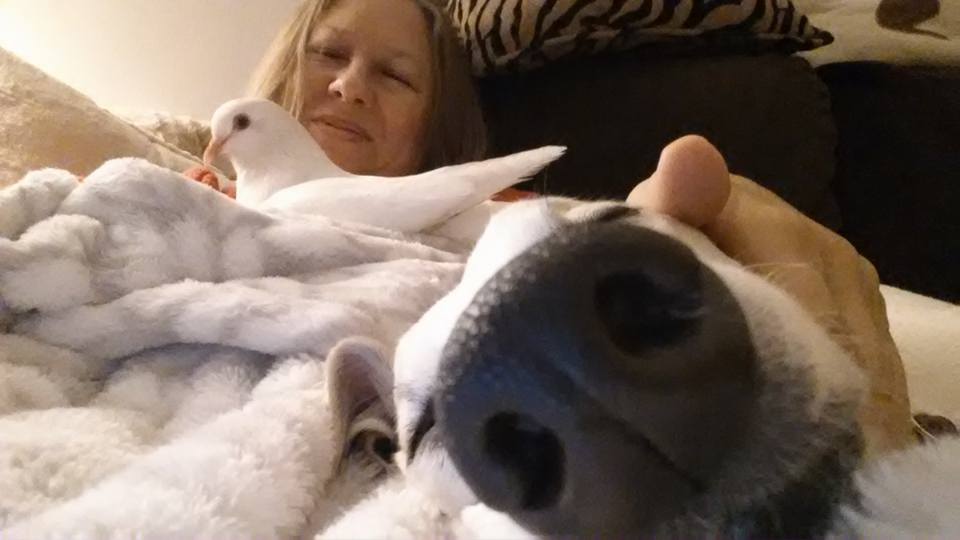
Jill, Tango & Jasper having a safe snuggle
Often, while introducing pigeons to the public, I hear people say “I can’t have birds, I have cats (or dogs)” to which I reply, “So do I!”. They usually look surprised and ask how is that possible? It takes patience, care and common sense.
I’ve had dogs (at least three) and cats since I rescued my first pigeon in 2011. Not knowing I would be keeping Elinor, I introduced my dogs and cats to him slowly. Elinor was recovering from partial wing amputation when I brought him home so it was important to keep him in the house. My dogs had never been around a bird before, other than seeing them outside on our walks. I’d like to note as well that I have sight hounds, known for their deep instinct to hunt based on sight, not smell. Elinor was sequestered in a room, by himself, to quietly heal. In the few weeks he spent in the house, my dogs could smell and see him from time to time when I brought them in the room, one by one, always with Elinor safe in his cage. These were very short visits and I always praised them for ignoring him and focusing on me.
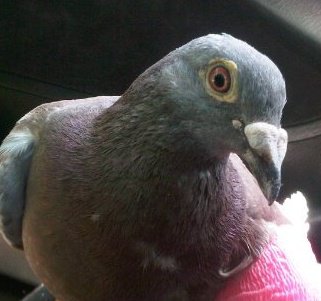
Pigeon-racing survivor Elinor recovering
It didn’t take long for my dogs to figure out Elinor was a part of the pack and, in my dogs’ eyes, quite boring. He didn’t flit around, but rather stayed in one spot and preened, looked out the window and well, didn’t do much. This is typical pigeon behavior. They are masters of the leisure arts, spending much of the day napping, preening and eating. After a couple of weeks, they saw him as a fixture in this house.
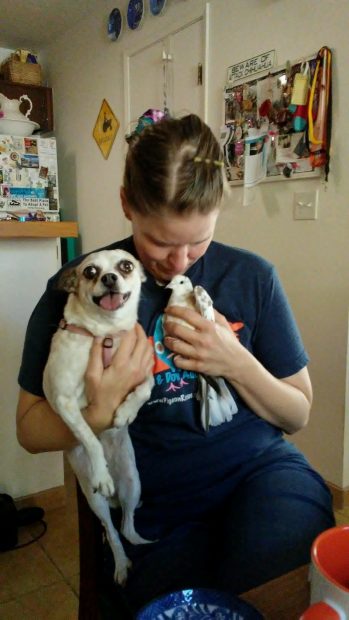
Not all dogs are chill with pet birds. Liese, shown here with foster dove Legion, supervises her dog Lily carefully.
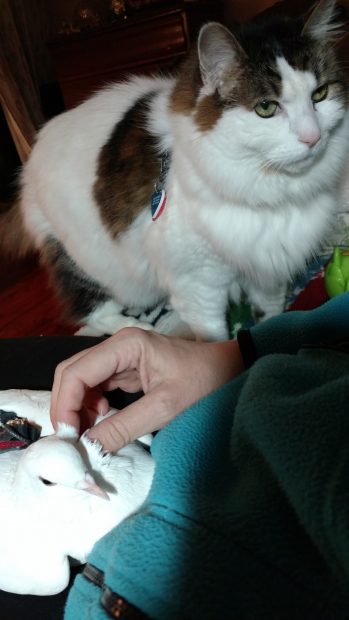
Fizzy patiently waiting his turn…
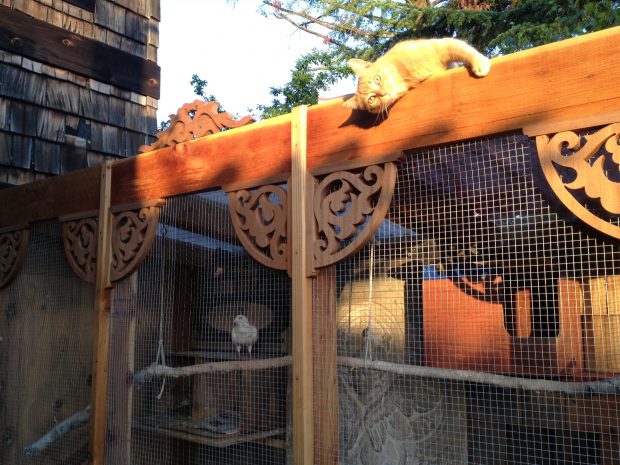
Cats love aviaries and the birds safe inside, like Laurie’s Polka Dot shown here, find the cats more amusing than worrisome.
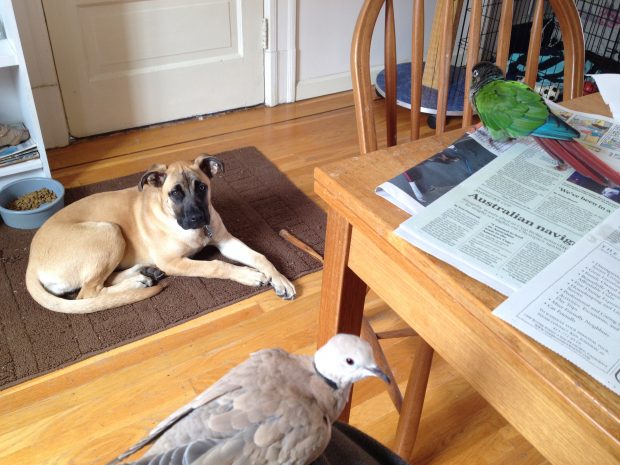
Pup Ruby learning about life with birds, dove Lily & parrot Tookie. (Birds can hurt one another & need to be managed carefully as well.)
In my experience, it’s important to let the other pets see the bird, smelling and getting a feel for bird behavior, the wing flapping, and the sounds ALWAYS IN A SUPERVISED AND CALM SETTING and always for short amounts of time, lengthening the exposure as time went on. I would often walk into the room with one dog at a time and focus my time and energy on something other than Elinor, then walk out – always giving the dog a treat for being calm and listening to me. If there was any excitement, we’d exit the room, no treat and enter again. Calm behavior was what I was looking for. If this sounds labor intensive, it really isn’t. It’s 5 minutes here, 10 minutes there. In the long run, it’s worth it.
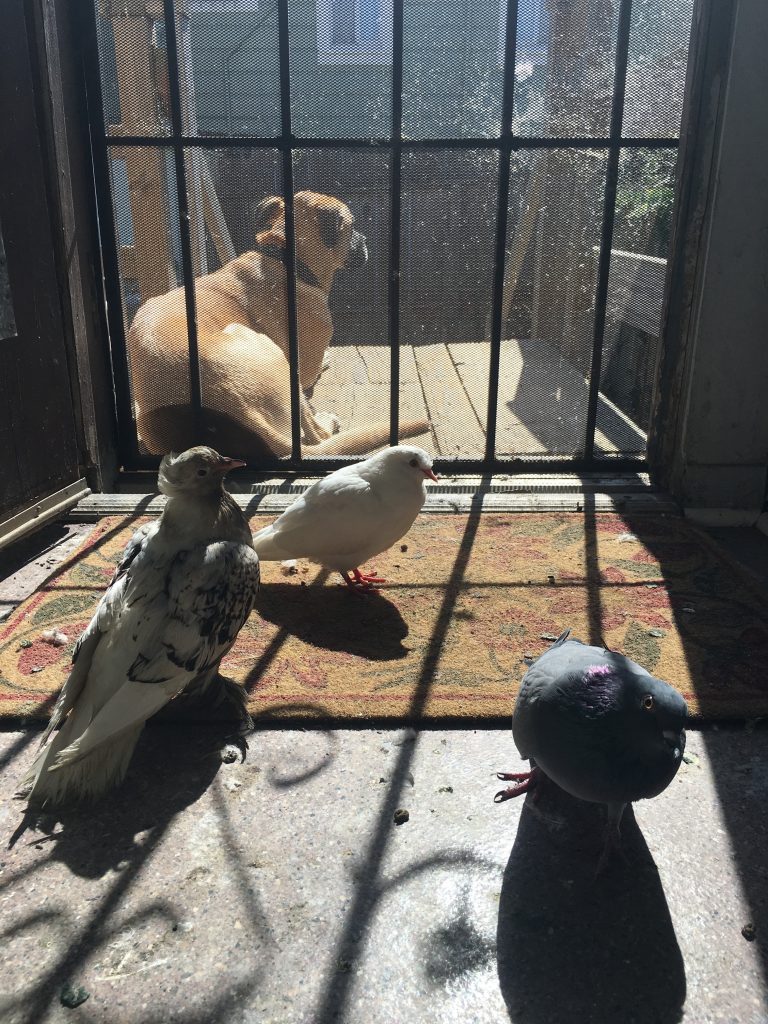
Foster pigeons JJ, Bug & Charlie hanging out in the sun with Elizabeth’s dog Ruby
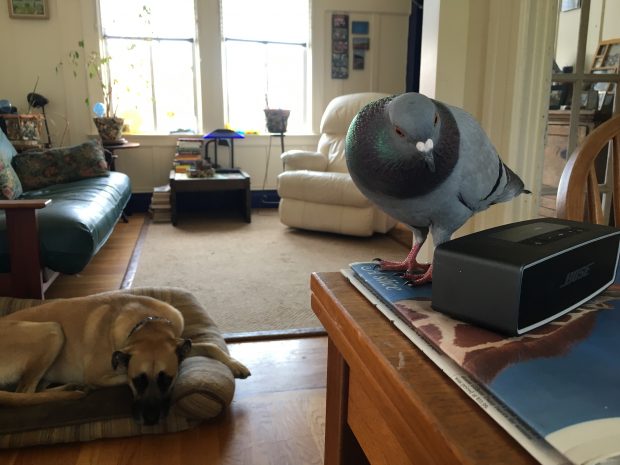
Ruby was taught that birds are off limits but she is still never unsupervised with out-of-cage birds
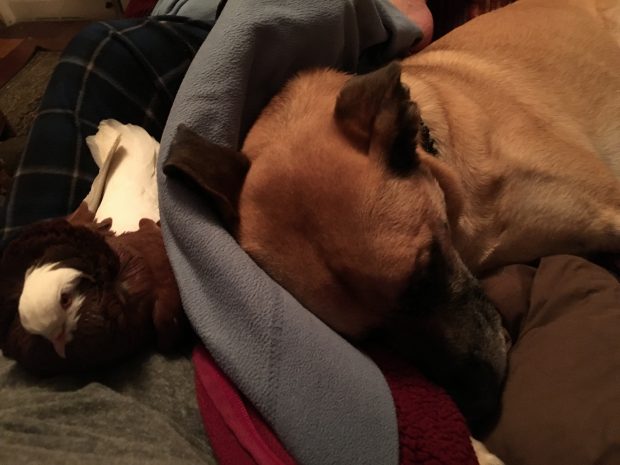
Quiet times are especially good for supervised hanging out together as Elizabeth, Jacob and Ruby are here.
Here are some guidelines and ideas that I think are important –
- It’s ALWAYS important to make the bird feel secure. A stressed-out pigeon isn’t a happy pigeon. Once pigeons know they are safe, their confidence level goes up. They know that their cage equals safety. I never let the dogs invade their space. This includes when a pigeon is out and they’ve claimed an area (usually high up) that they feel is theirs. If it’s their cage, the dog isn’t allowed to stick their head in the cage or invade that space.
- Supervision. Always. If I have a bird loose in the house, I don’t leave the room without the bird. Ever. I will never trust my dogs or cats 100% if left to their own devices. Instinct is instinct.
- Common sense. If the bird remains in a closed room and is never exposed to your other pets, it’s natural that their curiosity will make them crazy. To know a pigeon is to love a pigeon, even for dogs.
- Wherever your birds are housed, their enclosure needs to protect them from the animals that have access to it. If you have cats, an indoor bird’s cage needs to have narrow bar-spacing to keep paws out. Even a small nick by a cat claw can result in death to a bird. Cats and dogs carry deadly bacteria in their mouths and claws called pasturella. I’ve had the unfortunate experience of seeing a pigeon suffer a slow and excruciatingly painful death when I wasn’t told a cat caught a pigeon I had picked up at a good Samaritan’s house. Even as someone who knows how to look over a pigeon for puncture wounds, I missed one and by the time I got her to the vet she had to be euthanized. Feathers hide a lot.
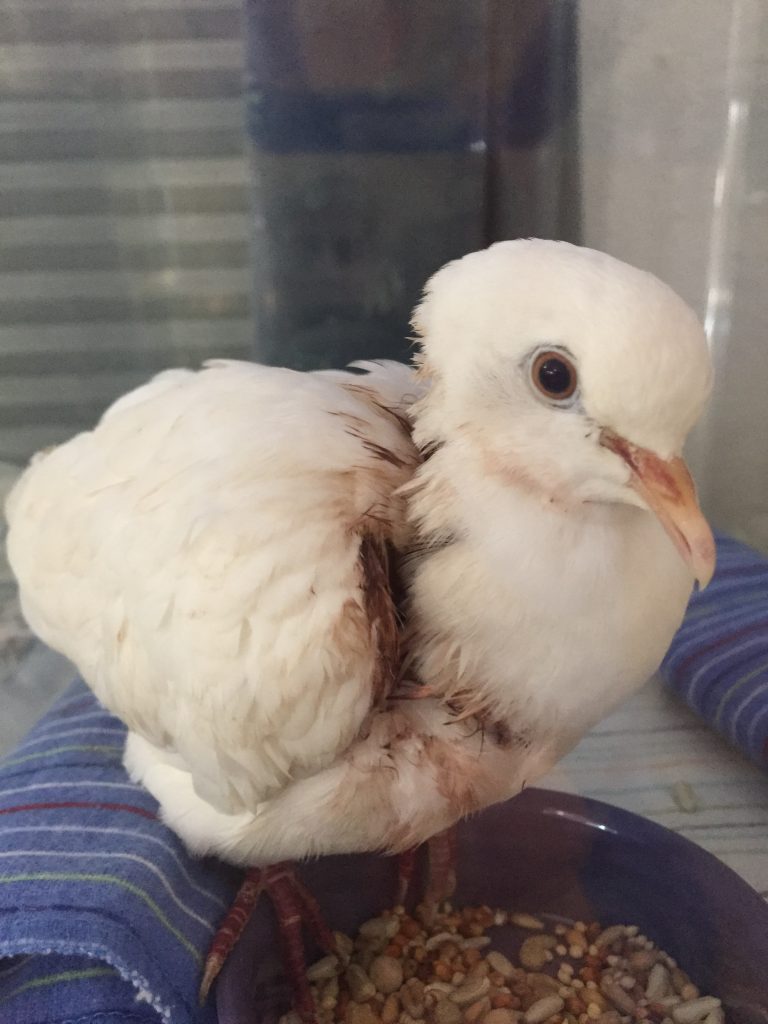
Dove Carl, housed in an unsafe cage, was nearly killed by one little kitten paw reaching in. (Palomacy rescued him.)

Jill & Georgie (Photo by Elisabeth Millay)
Jill is the partner to a scientist/farmer, mother of three plus two bonus kids, caregiver and animal lover. She has rescued dogs, cats, chickens, amazing pigeons and a deer mouse named Bizzee. She’s living the dream on an acre of land in Sunol and feels absolutely blessed to have found Elinor the racing pigeon on the side of the road in 2011. He came HOME with me that day and life has never been the same.
May 4, 2017
by Elizabeth
Comments Off on Fergus the Feral
Fergus the Feral
Guest Post by Emily Riska
June 23rd, 2016 was a very bittersweet day at Cheat Lake Animal Hospital in Morgantown, West Virginia. I was working an 11-hour shift, and I started my day off terribly by finding out that the ACCA’s very first educational ambassador bird, Luna, a stunning Barn Owl, had passed away overnight. She was a diva, but boy, was she special. She loved being out on the glove in front of people, moving her cute face side to side to listen to everything going on. She was the first larger bird I felt comfortable handling, though she was still intimidating! Needless to say, we were all very devastated and solemn that summer morning.
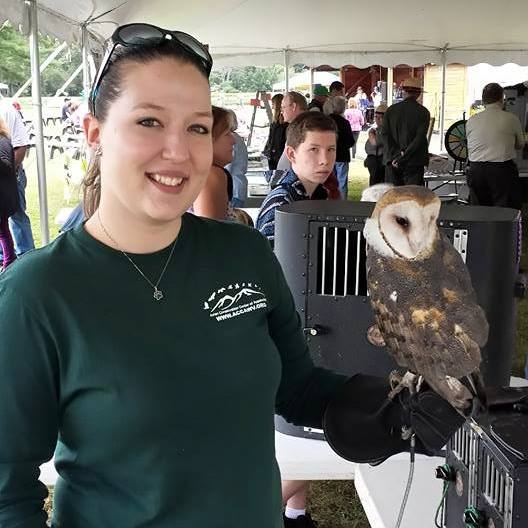
Me with Luna at a festival
The Avian Conservation Center of Appalachia (ACCA) is a wild bird rehabilitation and conservation group that runs out of Cheat Lake Animal Hospital. The volunteers, myself included, work very hard to educate the public through various programs and presentations on how native birds are important to our ecosystem and how to conserve these species. We are licensed to give medical treatment, including euthanasia if necessary, to any bird species native to West Virginia, aside from game birds like turkey. Occasionally, raptors with non-life-threatening injuries that cannot survive in the wild will become our educational ambassador birds.
Later that day, a kind Samaritan brought us an injured feral pigeon he had found. He was very concerned about the bird’s welfare, and he even donated $100 to the ACCA when he dropped the bird off. I don’t remember how I ended up with him in my arms, but I remember just routinely walking around the clinic to find a cardboard box to stash him in until the veterinarian could assess him. I tucked him safely away and thought nothing of it…until later.
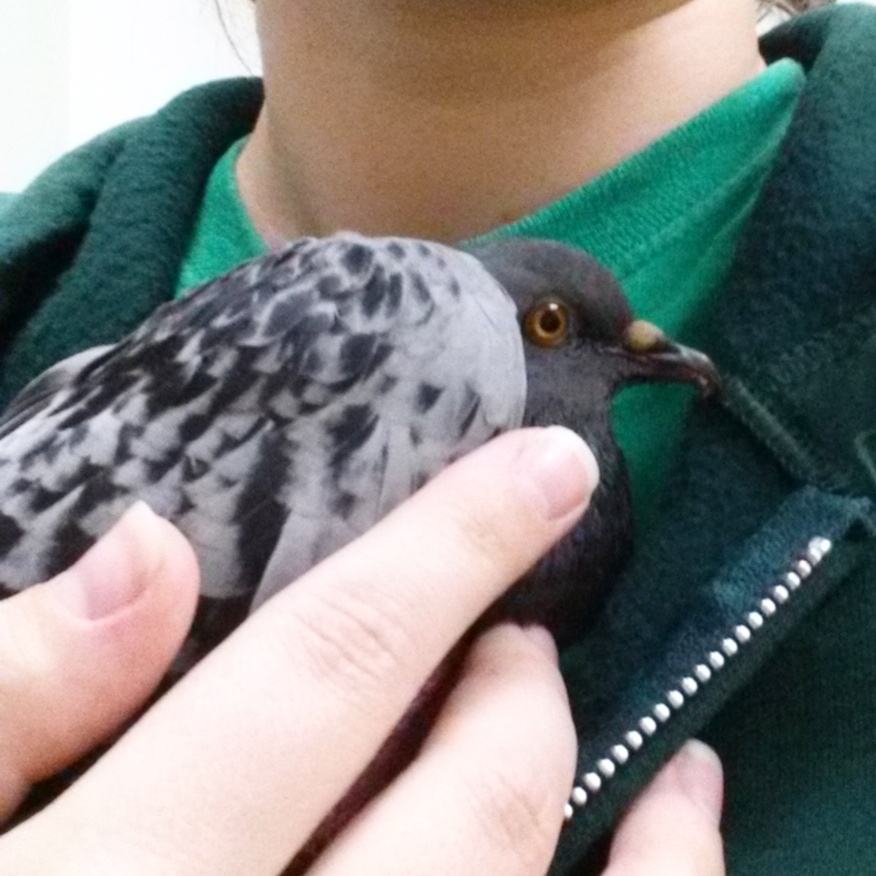
Fergus the day he arrived at the hospital
I came briskly walking around a corner, and another volunteer, Areil, quickly blurted out, “Hey, do you want a pigeon?” I stopped.
Areil was at a treatment table, holding a gas anesthesia mask over the pigeon’s head. Dr. Fallon, the ACCA’s vet, was at the next table down drawing up the “pink juice.”
“Uh, yeah. Can I do that? Legally?”
“Yep,” Dr. Fallon said, as he pushed the plunger of the syringe to replace the euthanasia solution into the bottle.
And that’s how I ended up with little Fergus. However, that isn’t the end to this story.
Since pigeons aren’t a native species, we cannot treat them or release them. On the other hand, as a non-native species, they can be legally kept as pets! Upon my adopting the pigeon, Dr. Fallon started diagnostics and treatment. Radiographs revealed a bad fracture at his “wrist,” as well as a BB pellet in his side. Someone had shot this gorgeous bird and left it to suffer and die a slow death, unless some predator came along and took advantage. My heart broke. He was a bit malnourished but otherwise in apparent good health.
A few days later, Dr. Fallon amputated half of that broken wing. It was a non-repairable fracture for sure. He lost all of his flight feathers on his left wing. He can no longer fly. The BB will remain in his side because it’s not causing any damage where it is.
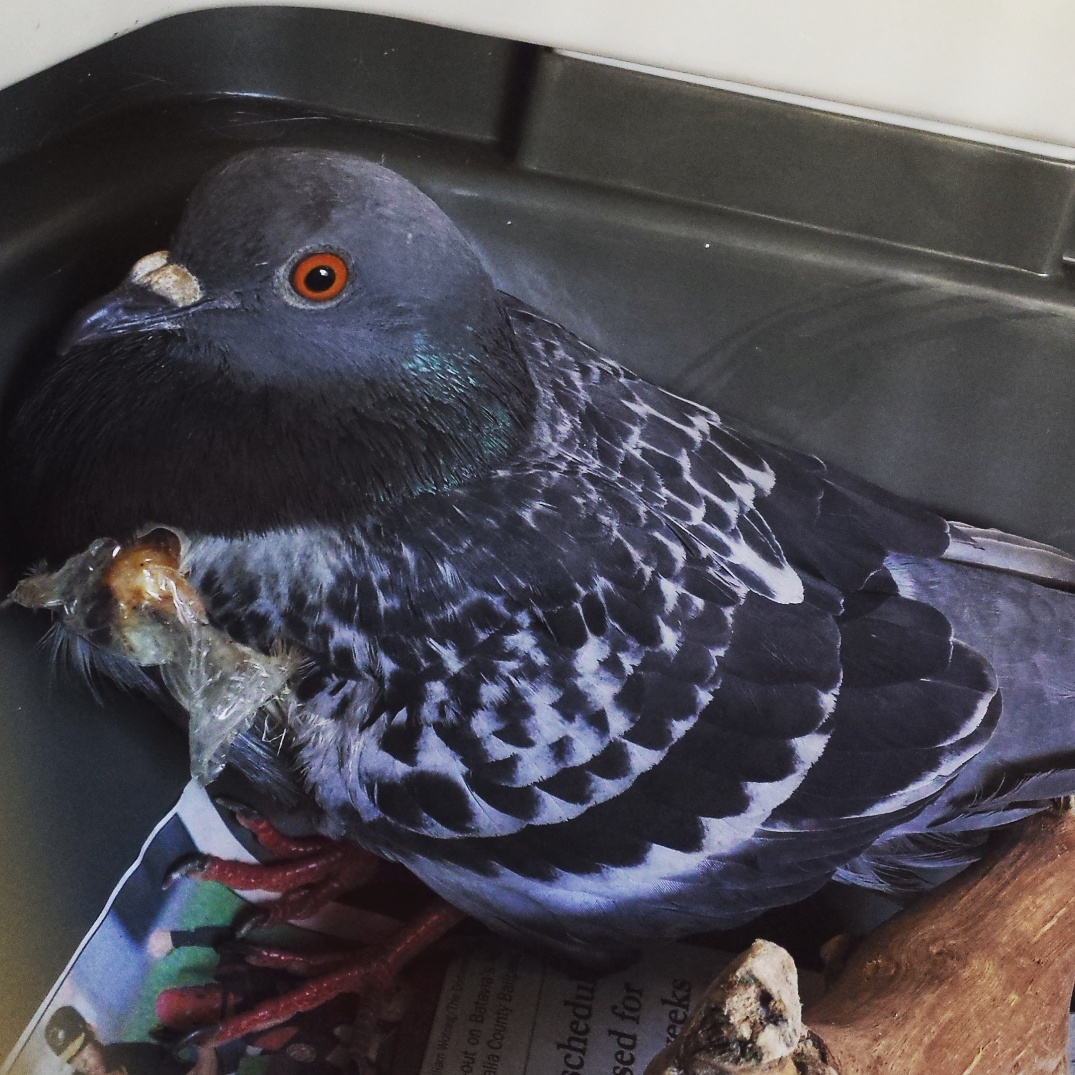
Fergus after his amputation surgery
After the amputation, I took him home. He had to stay in a cat carrier for a while until I could get the cage and supplies. Poor little dude was scared to death! Here he was, missing a wing, and in a weird place full of predators! (I have a dog and two cats.) I didn’t buy anything prior to the surgery because I’m superstitious, as most veterinary personnel tend to be. He was also on two oral medications, an anti-inflammatory for pain and an antibiotic for infection, and I’m sure medicating him was just the icing on the cake.
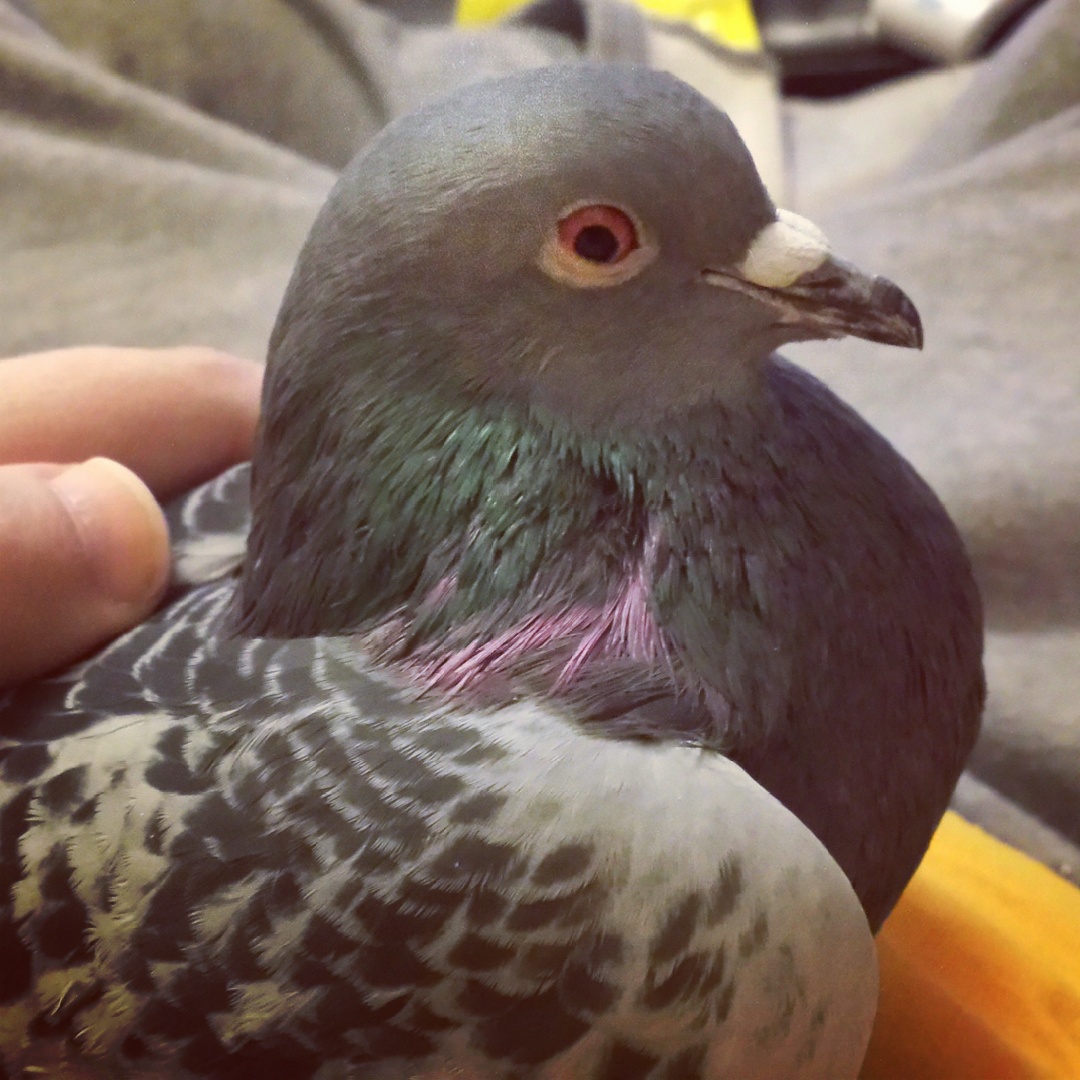
Happy boy!
Fast forward to almost a year later, and Fergus is living the high life. He is possibly one of the most spoiled “house pigeons” in the world. He is healthy, broody, and a diva just like his namesake. He easily shares this apartment now with his predator flock (as well as the two newest additions, the budgies). He wears a Flight Suit and leash, suns himself with me outside, and has gone to work with me! Walking around during your shift in a big veterinary hospital with a pigeon on your shoulder is pretty great for coworker and client morale alike.
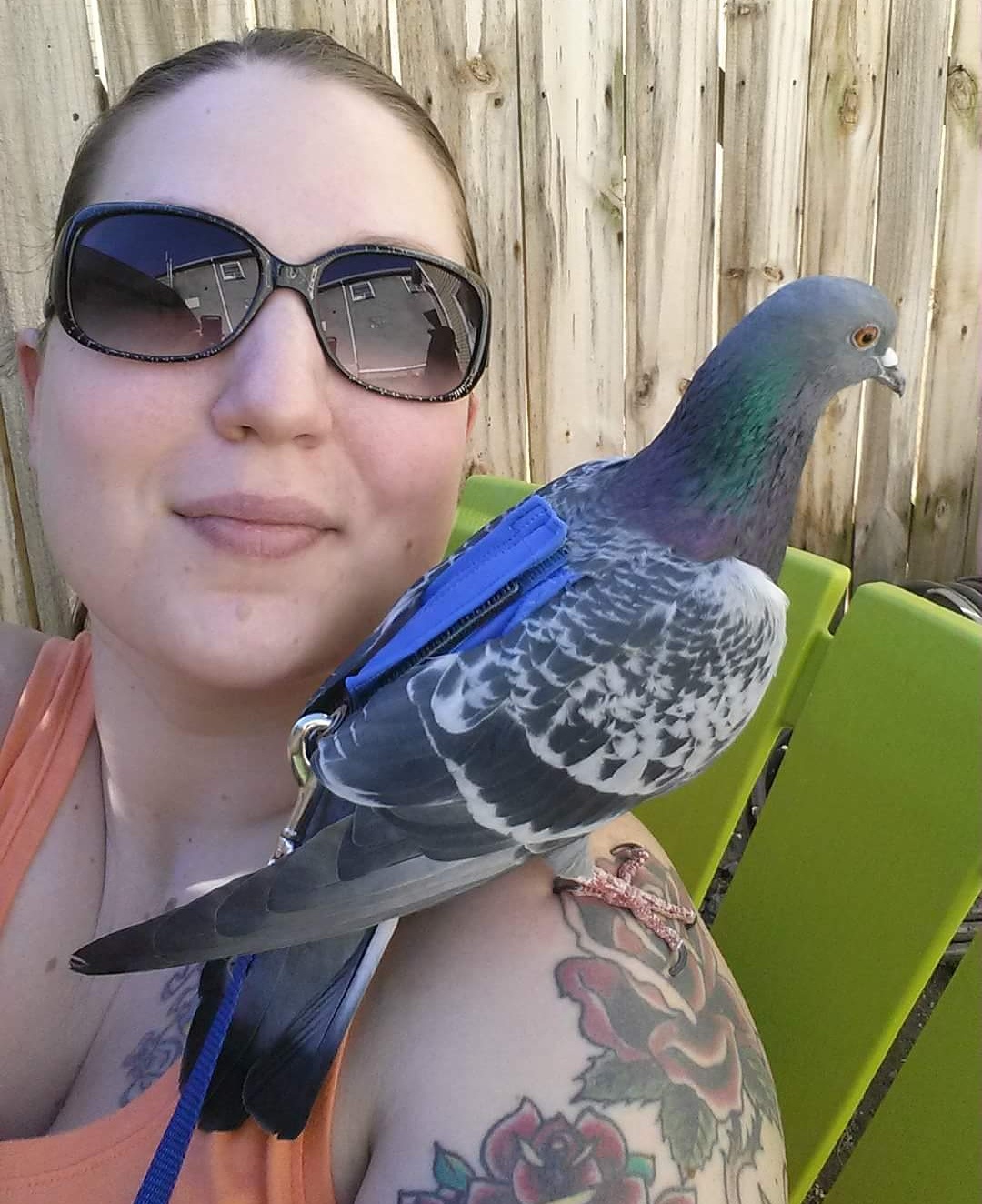
Outside enjoying the nice weather
Having Fergus in my life has been a blessing. He makes me laugh, and I learn from him every day. The budgies are fun birds, but pigeons are so different! The noises they make, the dancing, the territorial behavior of the cranky boys, etc. He scares the dog and the cats. (He did the Wing-Fu on them once, they learned quickly.) Pigeons are honestly one of the best pets I can imagine, as well. They’re clean, easy to care for, and like to sit with you and watch TV. What could be better than that?
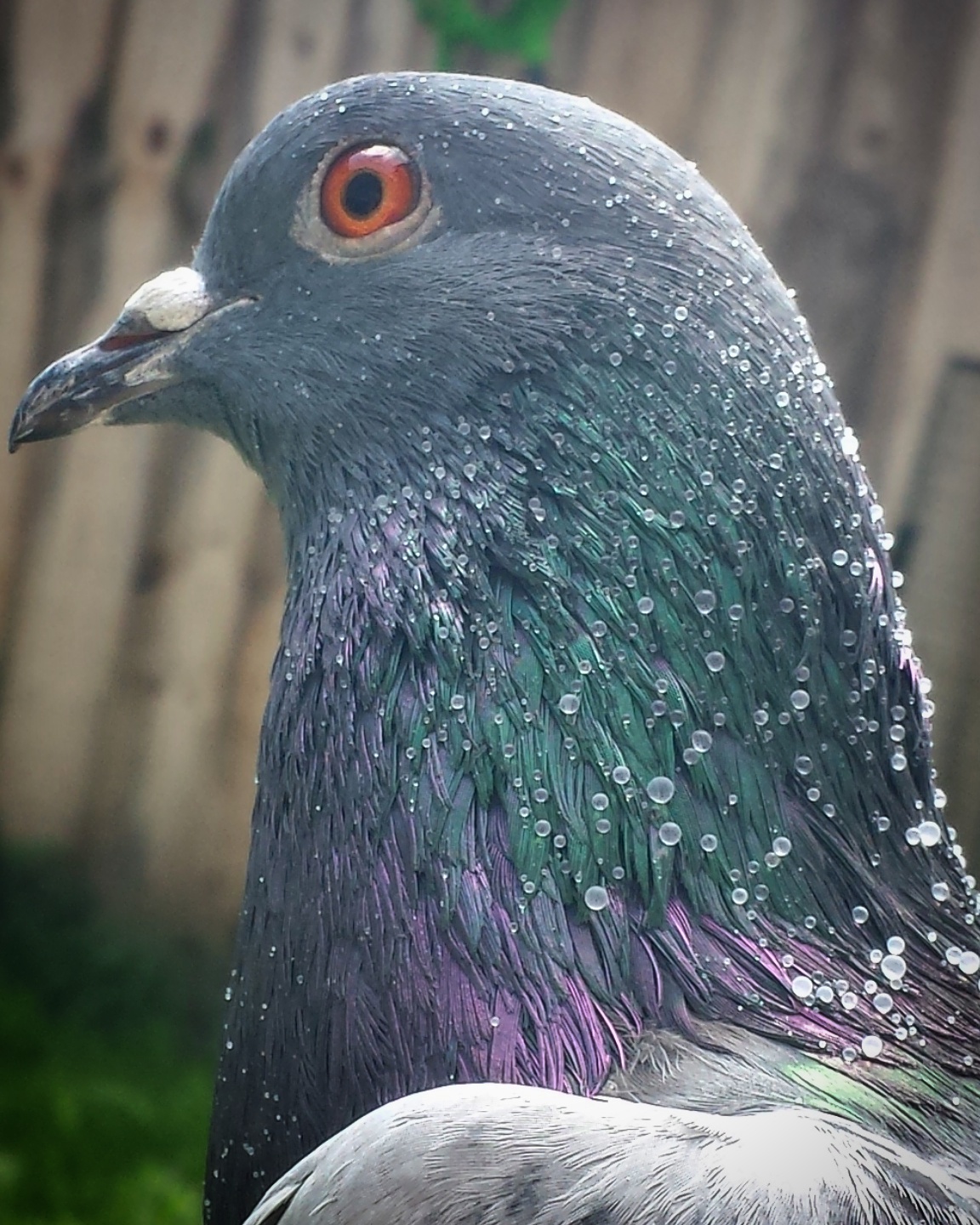
Beautiful creature
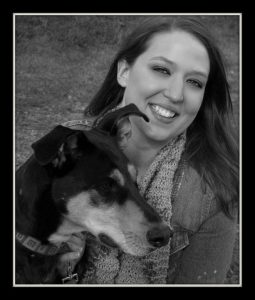 Emily Riska is a dedicated veterinary professional who has been in the industry for over 10 years. She also volunteers with the Avian Conservation Center of Appalachia (www.accawv.org), a 501c3 nonprofit organization whose mission is “to conserve the region’s wild birds through research, education, and rehabilitation.” She is passionate about advocating for pigeons whenever and wherever possible after welcoming Fergus, an injured feral Rock Pigeon, into her home. Fergus even has his own Instagram, @fergus_the_feral. Emily is an avid amateur birder, an outdoors enthusiast, and an aunt to three amazing nephews.
Emily Riska is a dedicated veterinary professional who has been in the industry for over 10 years. She also volunteers with the Avian Conservation Center of Appalachia (www.accawv.org), a 501c3 nonprofit organization whose mission is “to conserve the region’s wild birds through research, education, and rehabilitation.” She is passionate about advocating for pigeons whenever and wherever possible after welcoming Fergus, an injured feral Rock Pigeon, into her home. Fergus even has his own Instagram, @fergus_the_feral. Emily is an avid amateur birder, an outdoors enthusiast, and an aunt to three amazing nephews.
April 25, 2017
by Elizabeth
Comments Off on Saving Shmuel the Handsome West of England Tumbler
Saving Shmuel the Handsome West of England Tumbler
Guest Post by Olena Klingman
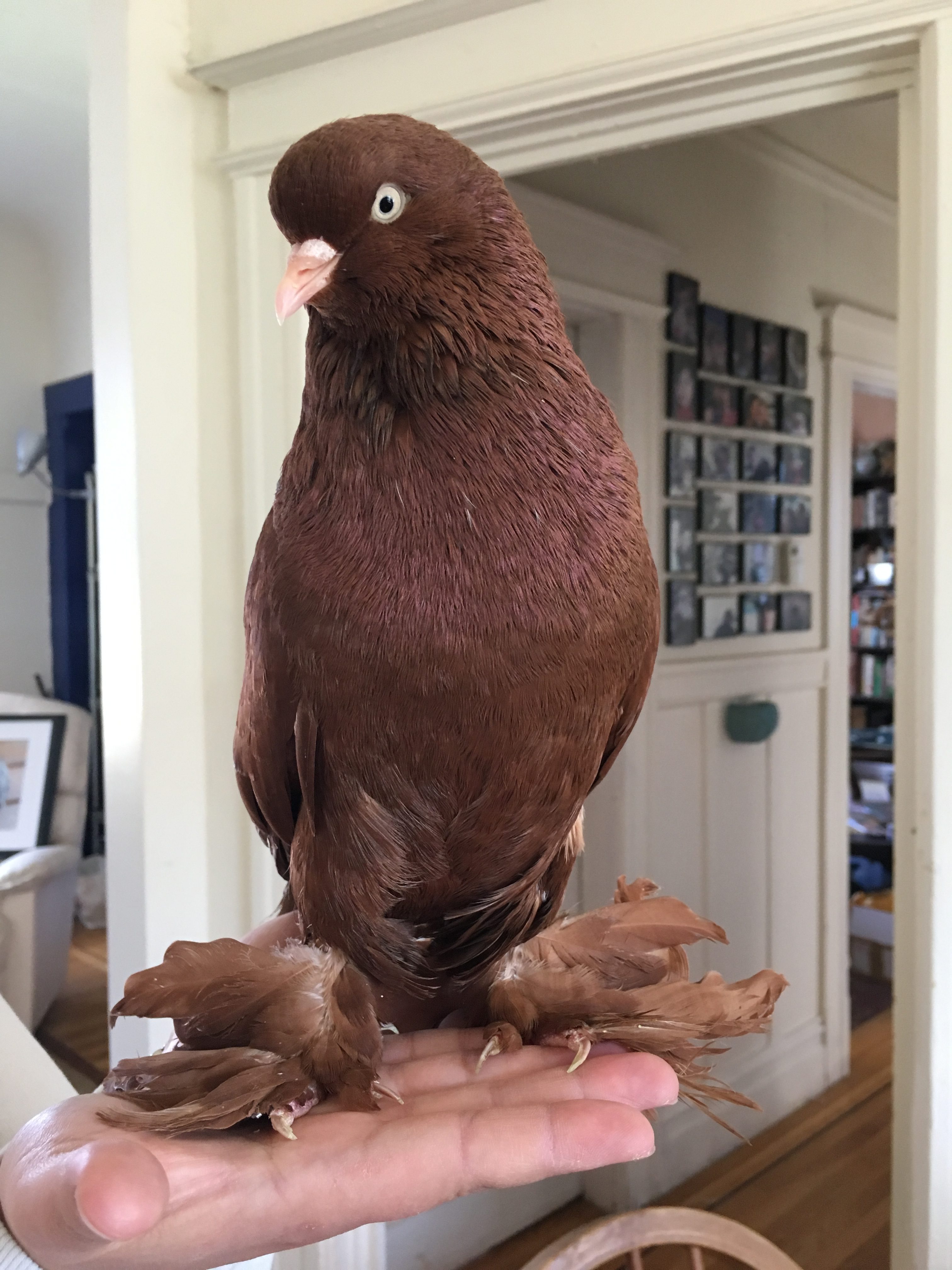
I have always loved birds and I have kept many different kinds of birds throughout my life. Usually I took ones that other people didn’t want or needed to re-home. I also helped to rescue wild birds by bringing injured or orphaned birds to the Wildlife Center of Silicon Valley for treatment and rehabilitation. This is almost what happened with Shmuel, a stunning West of England Tumbler domestic pigeon!
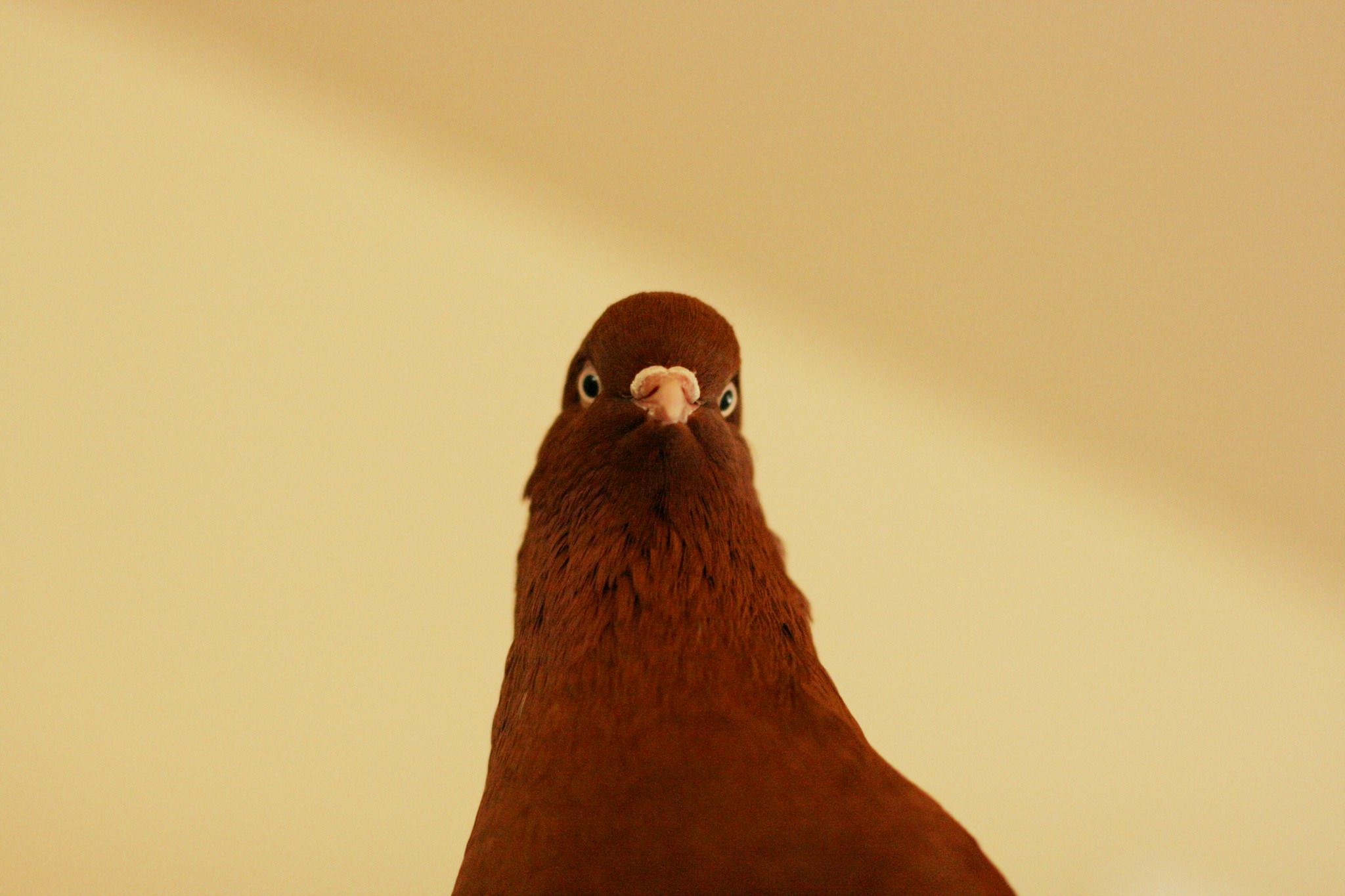
Shmuel
My best friend and fellow rescuer Olga found Shmuel at a shopping center parking lot in San Jose. She was shocked that he refused to fly away when she approached. Taking a closer look, she noticed he had clipped wings and beautiful long feathers on his feet and realized this pigeon was special. Still she called me right away for assistance saying she found “a pigeon that can’t fly” so my first instinct told me to take him to Wildlife Rescue. Next day we were both enlightened that yes indeed, he is special, he is no ordinary pigeon, he is a pure-breed pet! Our next step was to try to find the “owner” of this pet. Many Craigslist ads, posters and local shelter notices later, we only found a few questionable individuals and fake “rescues” who wanted to take him but no original owner. Since we know how many animals get abused by being re-homed online, we decided not to give him away and to foster him ourselves. After sometime my friend Olga realized she can not give Shmuel the environment that he needs in her home so she asked me to take over his care completely.
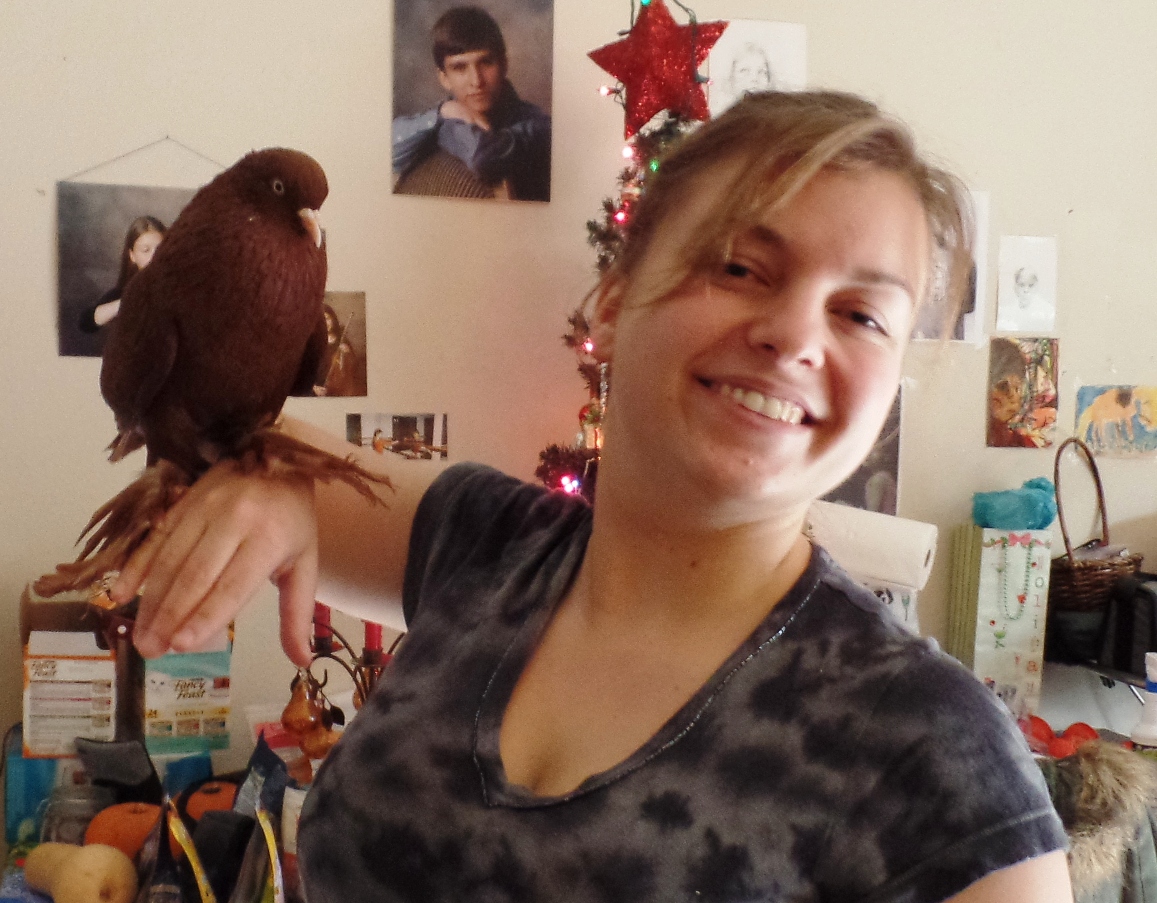
Shmuel & Olena
It’s been I don’t even know how many months, maybe even a year, that I lived with this beautiful and regal bird. I have always wanted a pigeon as a child, and in a way my dreams came true as I was living out the fantasy of having a tame pigeon sit on my hand. My mom decided to name him Shmuel, which means either “name of God” or “God has heard” in Hebrew. My mom and the rest of my family also found so much joy and pleasure in caring for this handsome boy, but it all did come at a price.
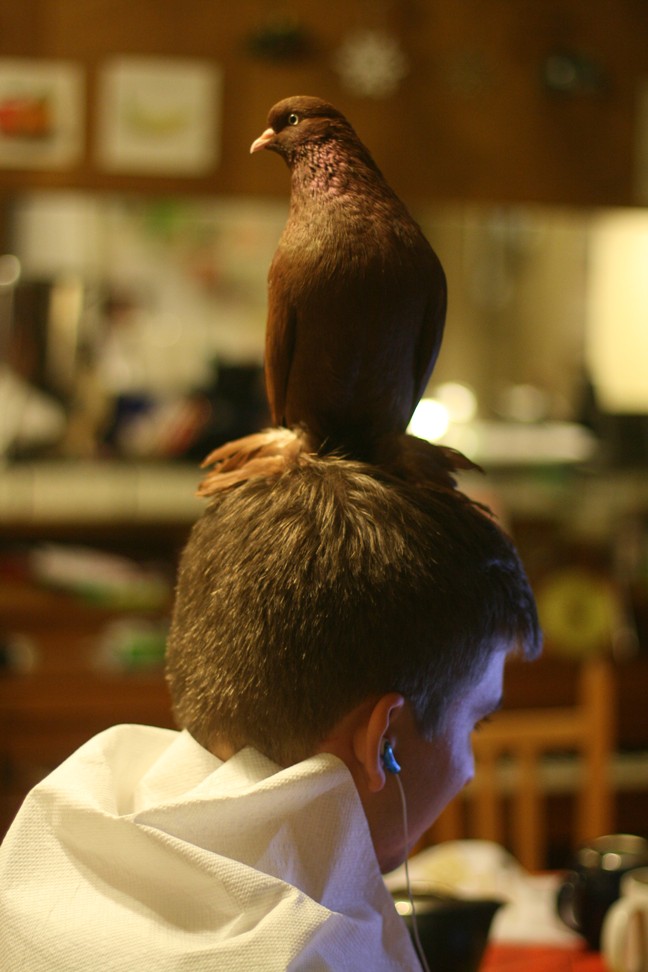
At the time I lived with my parents, brother and his wife in a small town-house and had to jump through hoops to make it work for everyone. I had a small room to myself that I practically had to convert to Shmuels personal flying and soiling space! We barely had a back yard big enough for any recreational usage, let alone an outdoor aviary. So the poor guy had to be cooped up indoors pretty much all the time and only got a chance to fly in my room. He did have a cage large enough for him to get around, spread his wings and nap in – I bought one that was originally intended for Chinchillas, so he really enjoyed all the platforms and ladders. The cage was open almost all the time except for at night, and he loved to go back in and out of it. Amazingly, he also responded to my commands when it was bed-time, I pointed my finger at the cage and said “mistse” which means “your place” in Ukrainian, and he would always respond by flying back inside!
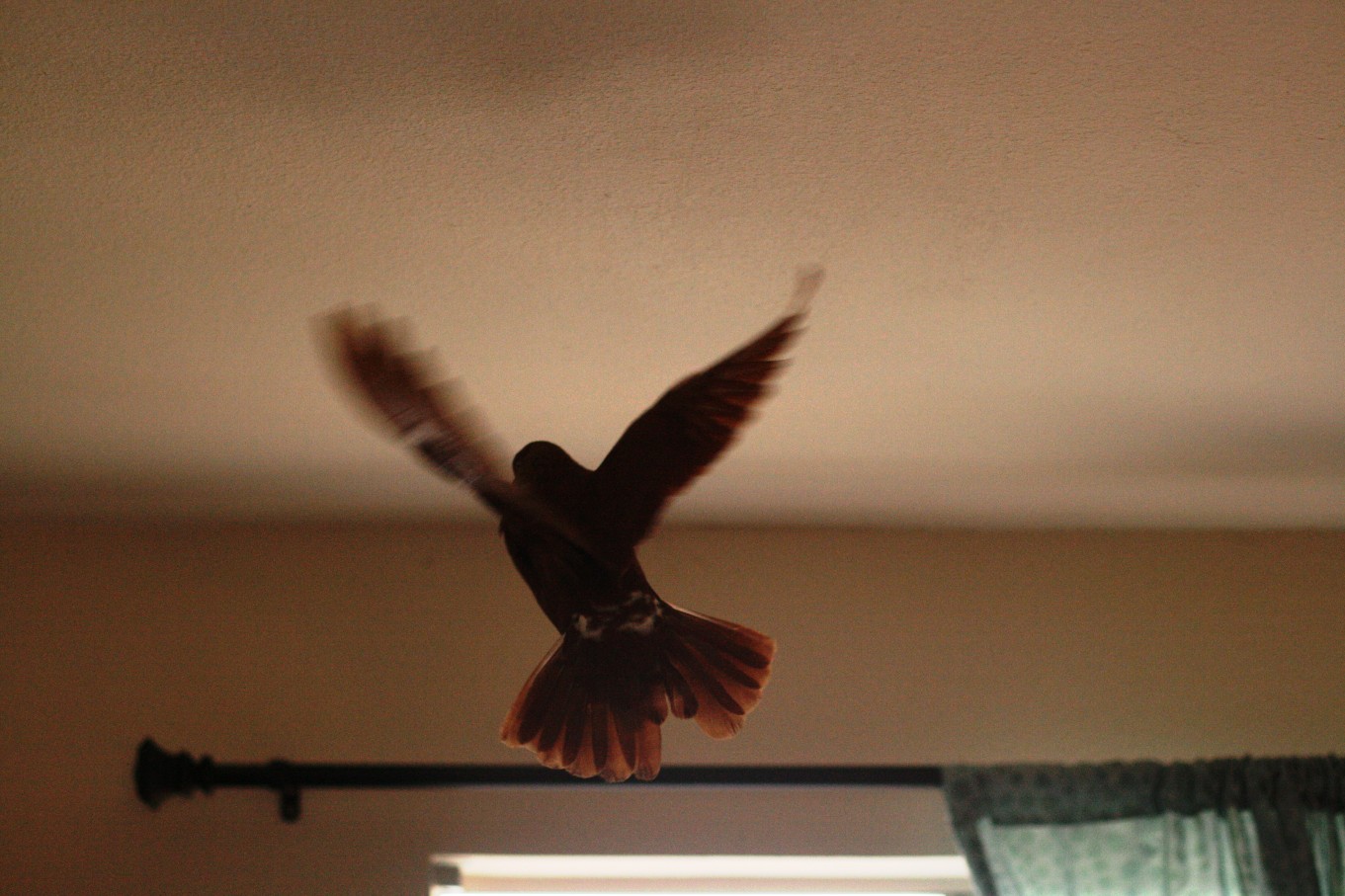
He seemed to be content and living a happy life, but still I felt like he needed more than I could give him. I also felt horrible that he was an only pigeon, he didn’t have a mate or a bird friend to play with, and adopting more birds unfortunately was out of the question for me at the time. I tried to entertain him as much as possible by taking him out of the room while he sat on my hand or even on my head! I also tried to stimulate his needs for social interaction by placing his cage next to a large mirror and even challenging him with a toy! He usually loved to fight my hand when I changed his food and water, so I figured I will try a stuffed animal instead if that’s what he likes to do, even though I didn’t know anything at the time about why he does this behavior. That’s another reason why I was afraid to re-home him. Knowing nothing about pigeons, I assumed that he might be aggressive and worried that in a different home he might become a victim of abuse if someone takes his territorial behavior the wrong way. That thought alone scared me and prevented me from moving forward with his placement for adoption.
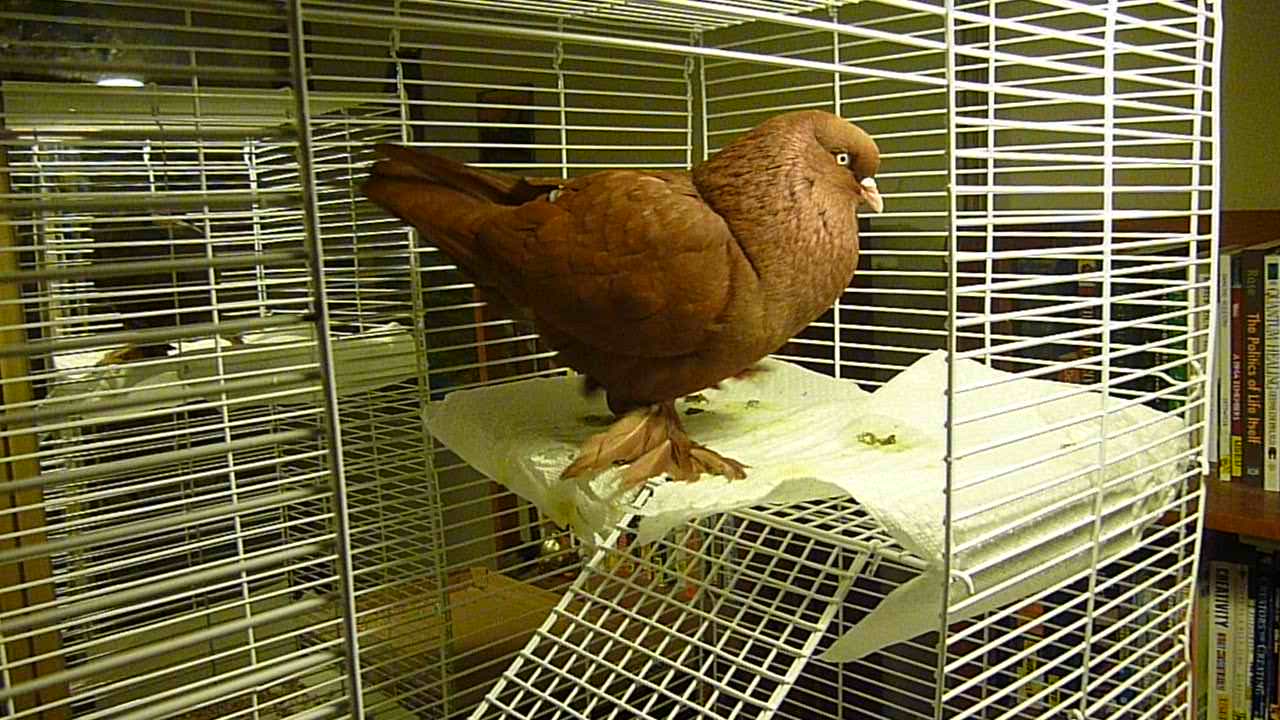
Eventually, I moved out of my parents home, got married and moved in with my in-laws (hardly an upgrade in living situation for most people, but knowing Bay Area home prices, it’s not an unusual living arrangement nowadays). That’s when I realized that I can not foster him anymore…and it broke my heart. Lost and panicked I couldn’t bare the thought of trusting another stranger to care for Shmuel. I reached out to my friends and neighbors only to be more disappointed that they can’t take him either.
Some online research lead me to find Palomacy and I finally felt like my prayers have been answered! Knowing that I had to re-home Shmuel within a month, I reached out to Elizabeth right away, pleading for help. I was amazed at how caring and understanding she was in helping me go through this situation. She not only offered a mountain of advice and explanation for Shmuels behavior, but she also agreed to take him into her foster care and give him a chance at a better life that I’ve always wanted for him. A week later I have brought Shmuel into her aviary, and he fit right in fairly quickly with other birds and felt at home flying around and enjoying the sunshine. I couldn’t be more happy for him knowing that he will now have a chance to find a “wife” and be adopted out as a bonded pair to a wonderful forever home. I had to give this one up and it’s so bitter-sweet to see him go, but knowing what I know now about pigeons and how much fun it is to have them, I will definitely look into adopting or fostering with Palomacy in the future (when I have my own home and enough space to build my own aviary), it’s the least I can do for all that Elizabeth and her staff have done for me and Shmuel.
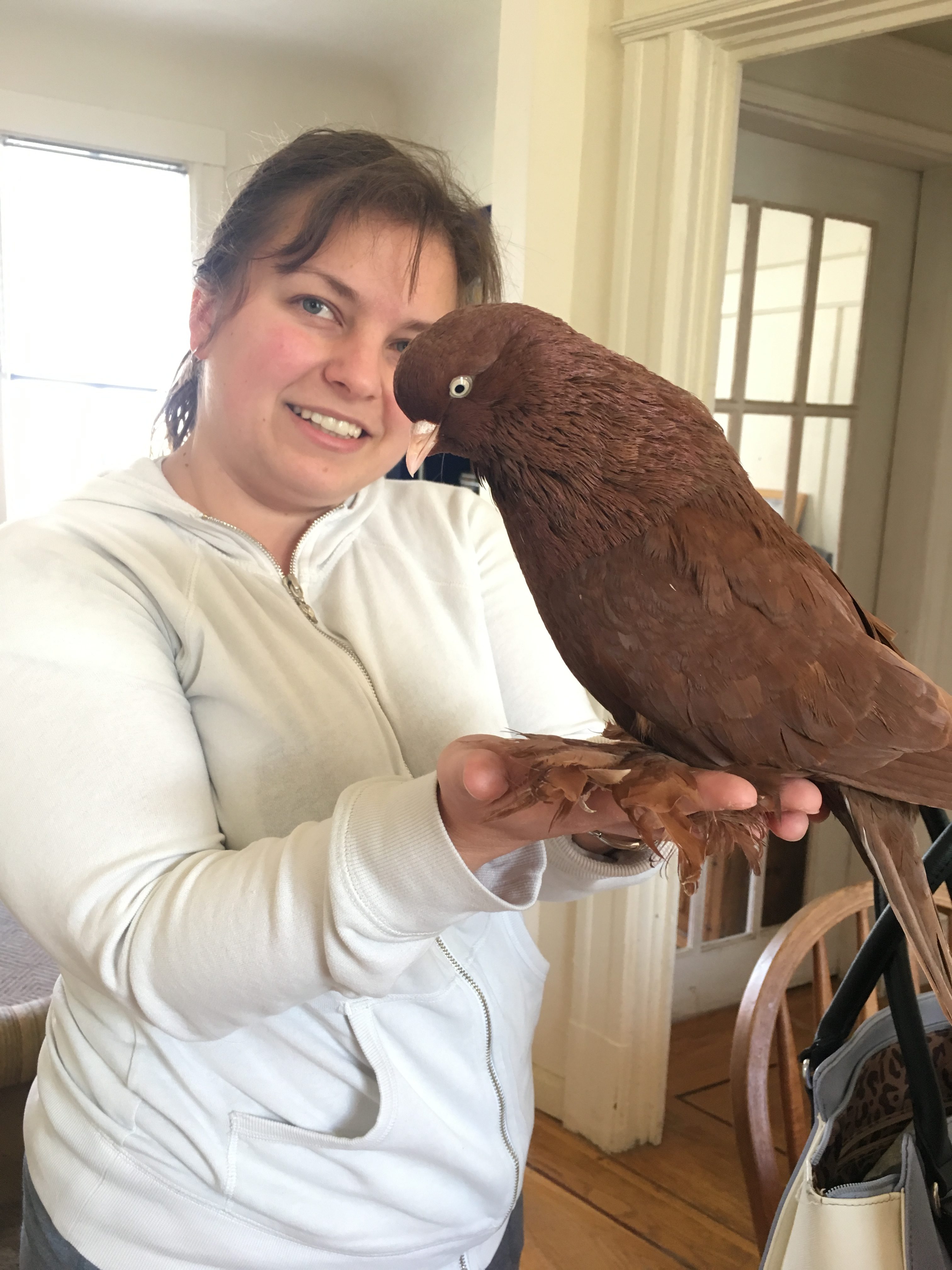
Olena brings Shmuel to Palomacy 3/23/17
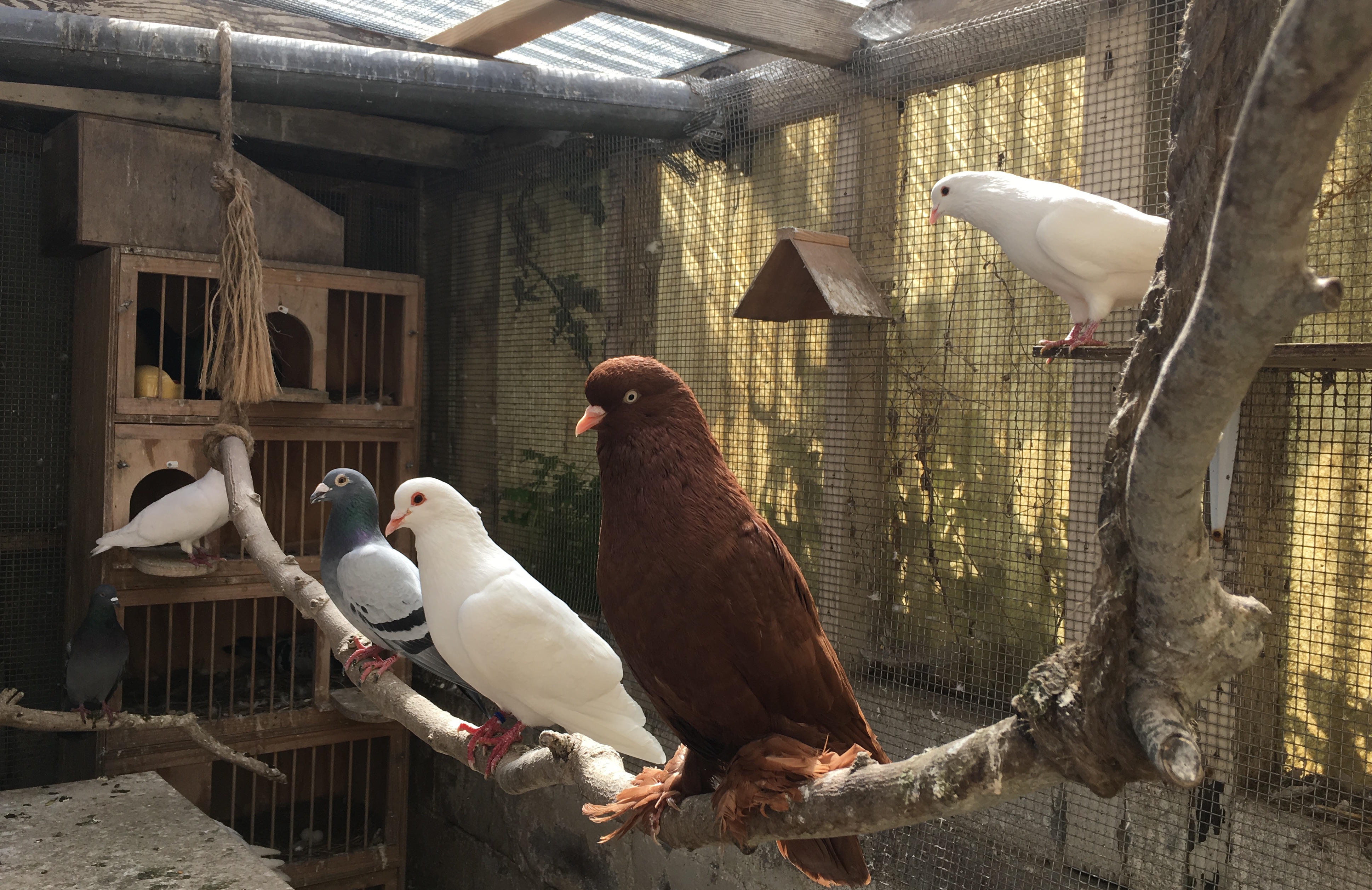
Shmuel joining the aviary flock
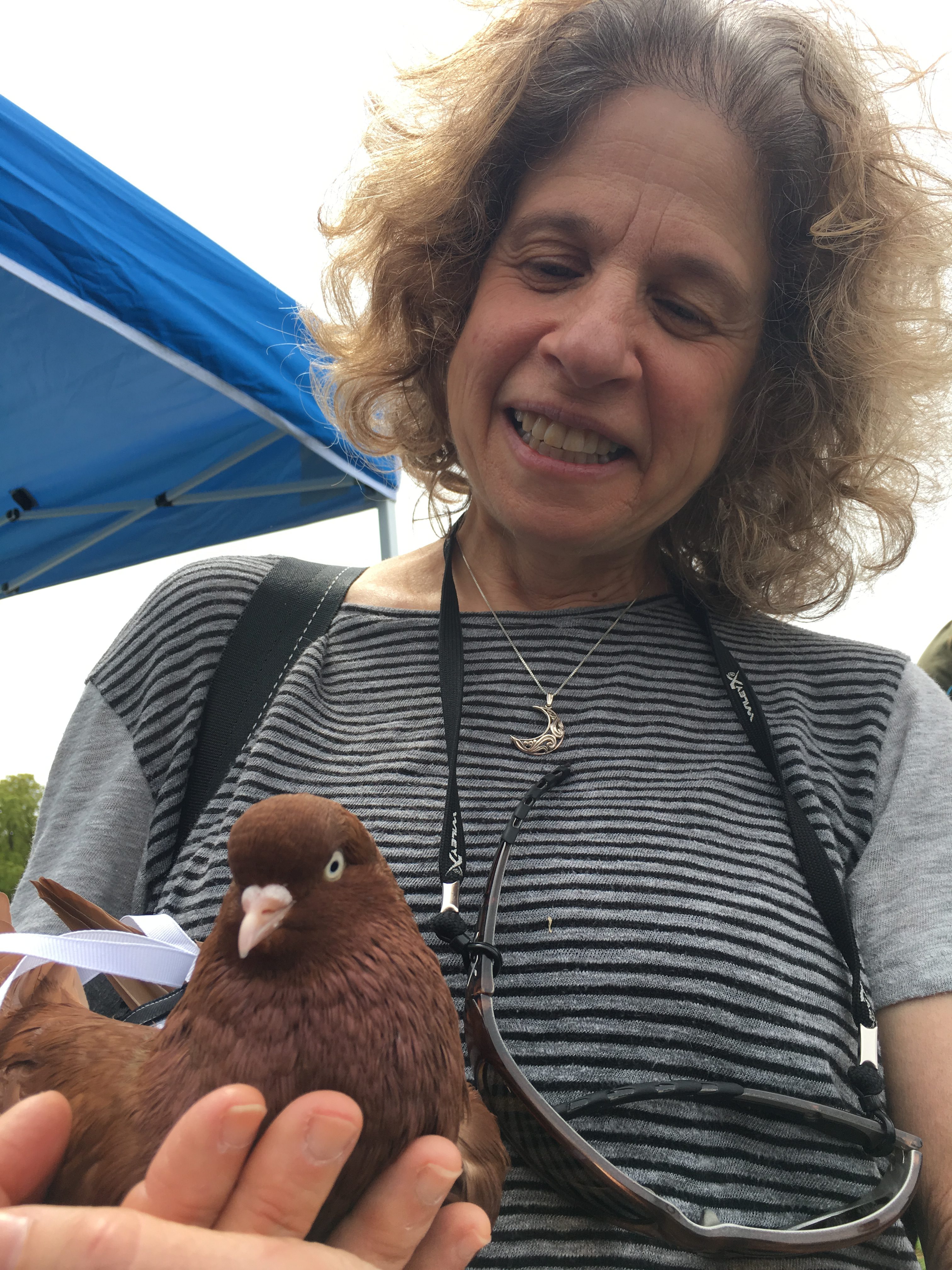
Shmuel making new friends for Palomacy at his first outreach 4/22/17
If any of you reading this are considering adopting him, please know that he is an amazing bird – he’s not only very beautiful, but his personality is just irresistible. He really is quite a gem and I truly believe that anyone would be very lucky to add him to their family.
Editor’s Note: Shmuel is currently fostered in Elizabeth’s San Francisco aviary. He is single, eager to have a mate and available for adoption. He is a very gorgeous, charming bird who would be happy in either an aviary or, with a companion, as an indoor family pet. If you’re in the Northern California area and interested in adopting Shmuel, please complete our online application. Palomacy thanks Olena for her loving care and advocacy for Shmuel as well as her generous donations and ongoing support. I wish every lost pigeon could find his way to someone like Olena.
 Olena Klingman is a dedicated professional musician, violin instructor and animal lover. She has been teaching private music lessons to children in the Bay Area since 2005. She grew up in Ukraine and always had a passion for rescuing animals, when not practicing her violin! Currently Olena lives in San Jose where she volunteers as a “dog socializer” at SJ Animal Care Center, and as a feral cat TNR specialist with Nine Lives Foundation in Redwood City. In her spare time, she enjoys traveling with her husband, singing, painting, and advocating for animal rights on her social media.
Olena Klingman is a dedicated professional musician, violin instructor and animal lover. She has been teaching private music lessons to children in the Bay Area since 2005. She grew up in Ukraine and always had a passion for rescuing animals, when not practicing her violin! Currently Olena lives in San Jose where she volunteers as a “dog socializer” at SJ Animal Care Center, and as a feral cat TNR specialist with Nine Lives Foundation in Redwood City. In her spare time, she enjoys traveling with her husband, singing, painting, and advocating for animal rights on her social media.
March 31, 2017
by Elizabeth
Comments Off on You Can Help Palomacy in All Kinds of Ways!
You Can Help Palomacy in All Kinds of Ways!
Did you know there are many different ways that you can help Palomacy to help the birds?
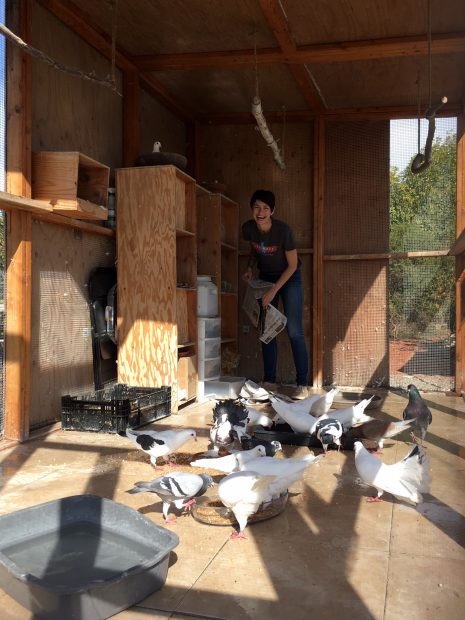
Aviary bird care volunteer Samantha caring for the Ploughshares flock
Palomacy needs volunteers to help with projects, transport, aviary bird care, fostering, outreach events and more!
Here are just a few of the opportunities available…
Aviary Bird Care Volunteers
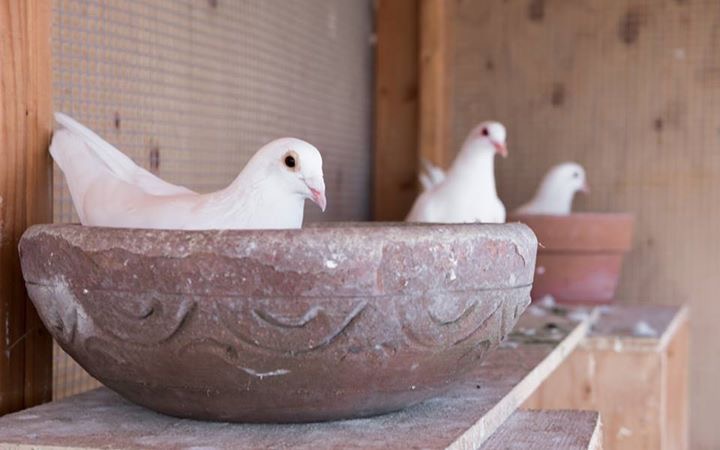
You can help care for adorable birds fostered in OUR aviaries!
Palomacy is currently seeking Aviary Bird Care Volunteers in Alameda, San Jose & San Francisco, CA! Warning: may be addictive! (Please complete our online application.)
ALAMEDA- We have a flock of 18 rescued pigeons fostered in our aviary at Ploughshares Nursery near the Main Street ferry terminal and we need volunteers to help care for them! The aviary needs to be cleaned every day and we currently only have three volunteers covering the seven days. Cleaning and feeding is very easy, it takes about 15-30 minutes, and is very fun! You get to hang out with 18 pigeons, and they’ll chat with you, and show off for you. They’re incredibly sweet and underappreciated animals.
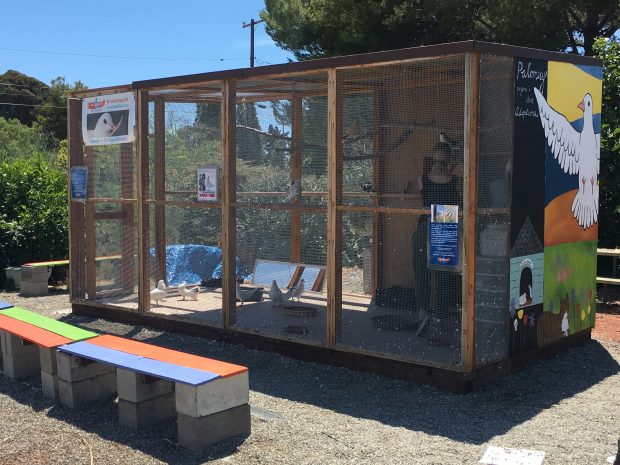
Palomacy’s foster pigeon aviary at Ploughshares Nursery in Alameda, CA
SAN JOSE- Have 20 minutes once or twice a week (or more)? We would love your help at our Foster Dove Aviary at Andy’s (Rescue) Pet Shop in San Jose and we are happy to train interested volunteers. The volunteer work includes cleaning our foster aviary and checking in on the ten doves. It can be a quick clean or you can hang out for a while with these fun, beautiful birds and watch them with their busy lives.
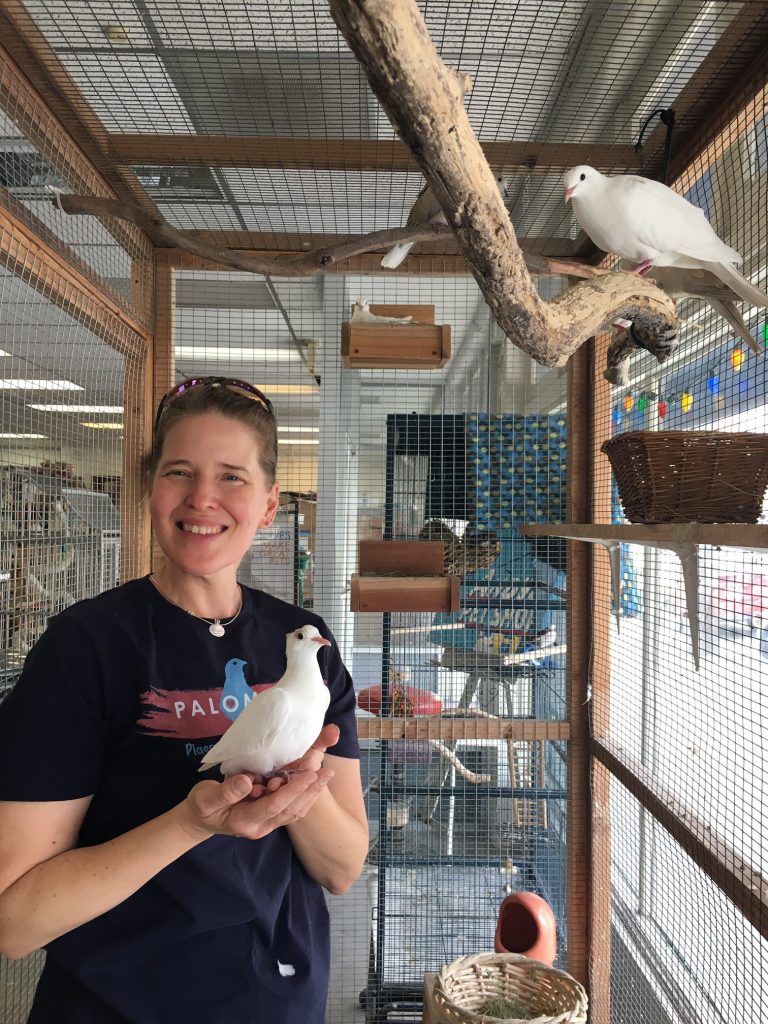
Palomacy volunteer Liese can teach you everything you need to know
SAN FRANCISCO- Aviary Bird Care Volunteer(s) needed to help feed, water, socialize and clean up after doves and pigeons housed in backyard foster aviaries in south east corner of SF (right near MUNI T Line & 101/280 connect, easy parking!). Work with Palomacy founder Elizabeth and learn all about pigeons and doves, rescue operations, doing the impossible, etc. Minimum commitment of 2 hours per week required.
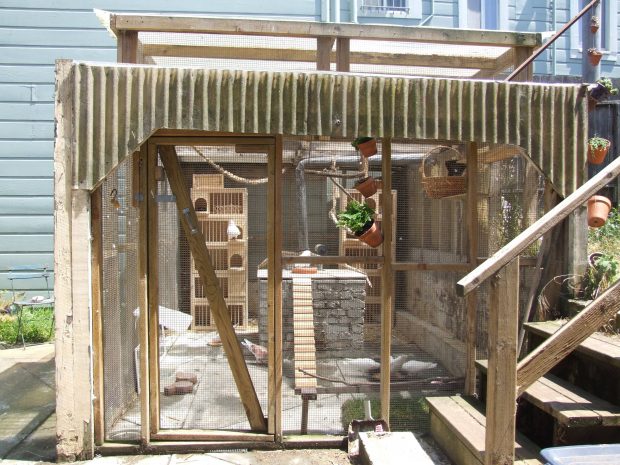
Elizabeth’s foster pigeon aviary in San Francisco
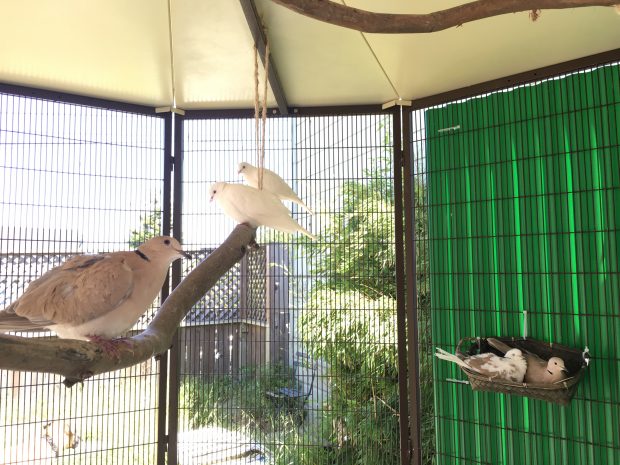
Elizabeth’s foster dove aviary in San Francisco
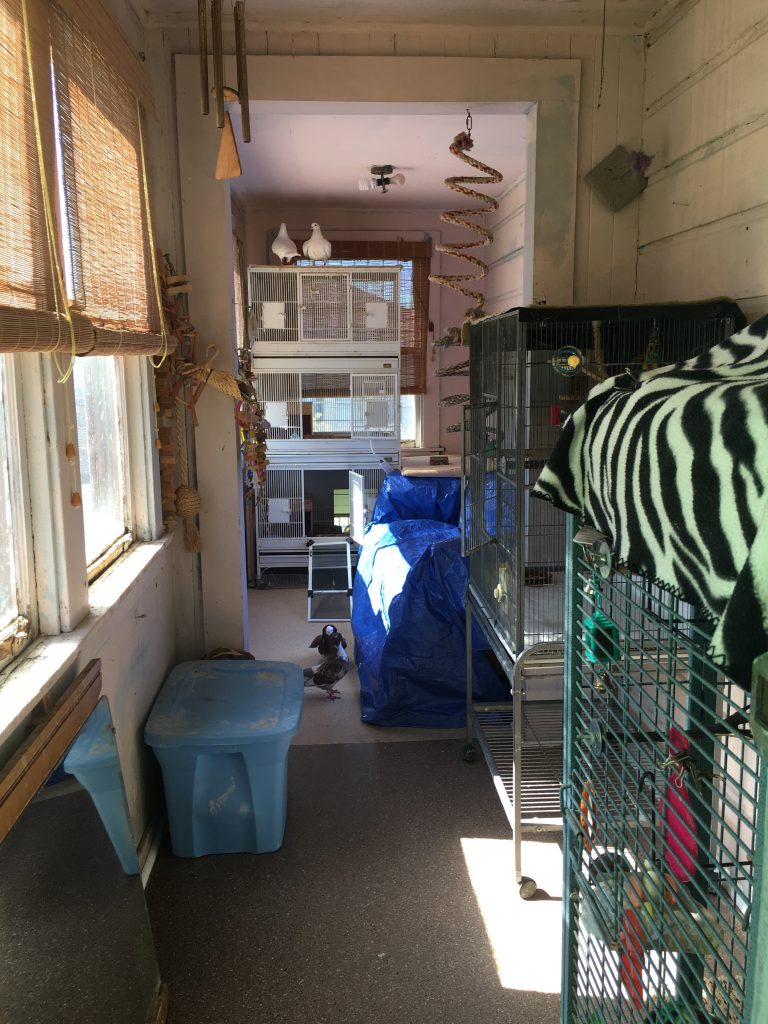
Elizabeth’s special needs bird room in San Francisco
Please complete our online application or contact Elizabeth if you have questions.
Outreach & Humane Education Volunteers
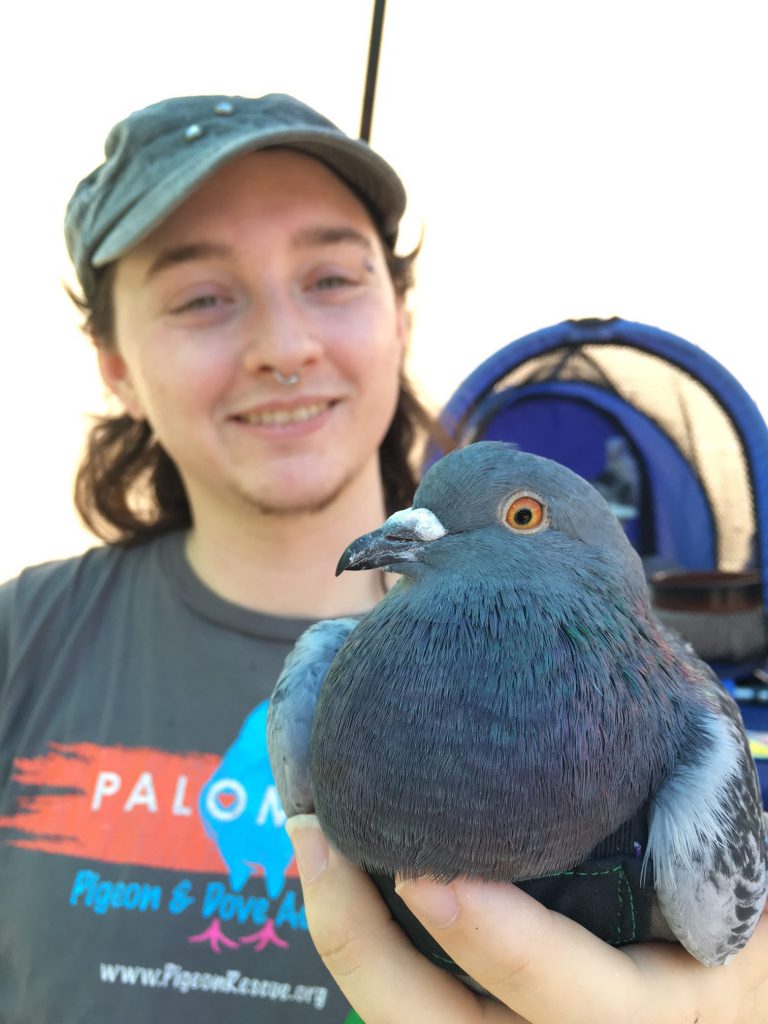
Palomacy ambassadors Max & Pirate
Palomacy brings pigeons and doves to outreach, adoption and Humane Education events througout the Bay Area, from San Jose up to Sacramento and everywhere in between. It is super fun and easy to introduce these amazing, charming birds to people and we make lots of new friends for them every time we do. We will teach you on the job and you can bring your own pet or foster pigeons and doves or we may be able to pair you with ours (depending on the event). You can see scheduled upcoming events on our website but there are always others being planned and, if we know you’re interested, we’ll invite you. Please complete our online application or contact Elizabeth if you have questions.
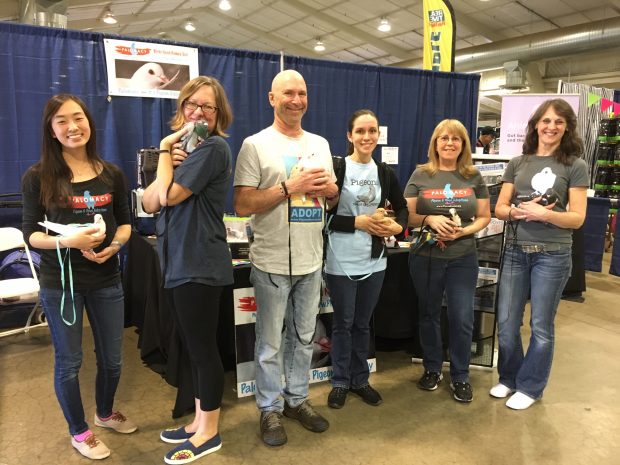
Pigeon diplomacy works!
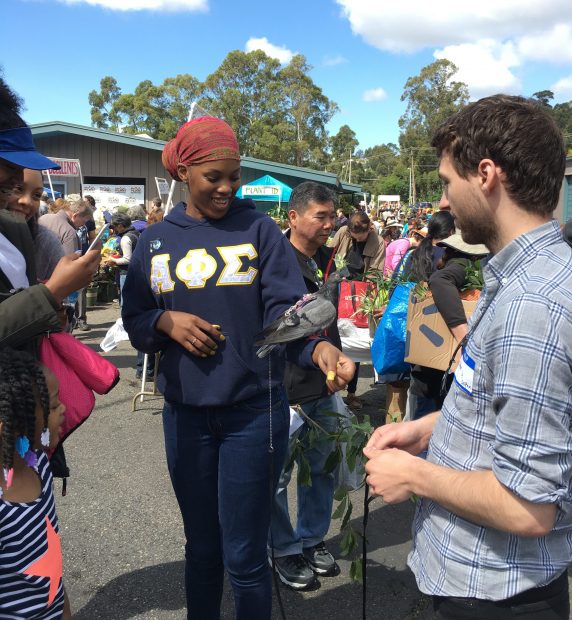
Jade meeting Nathan’s pet pigeon Sophia
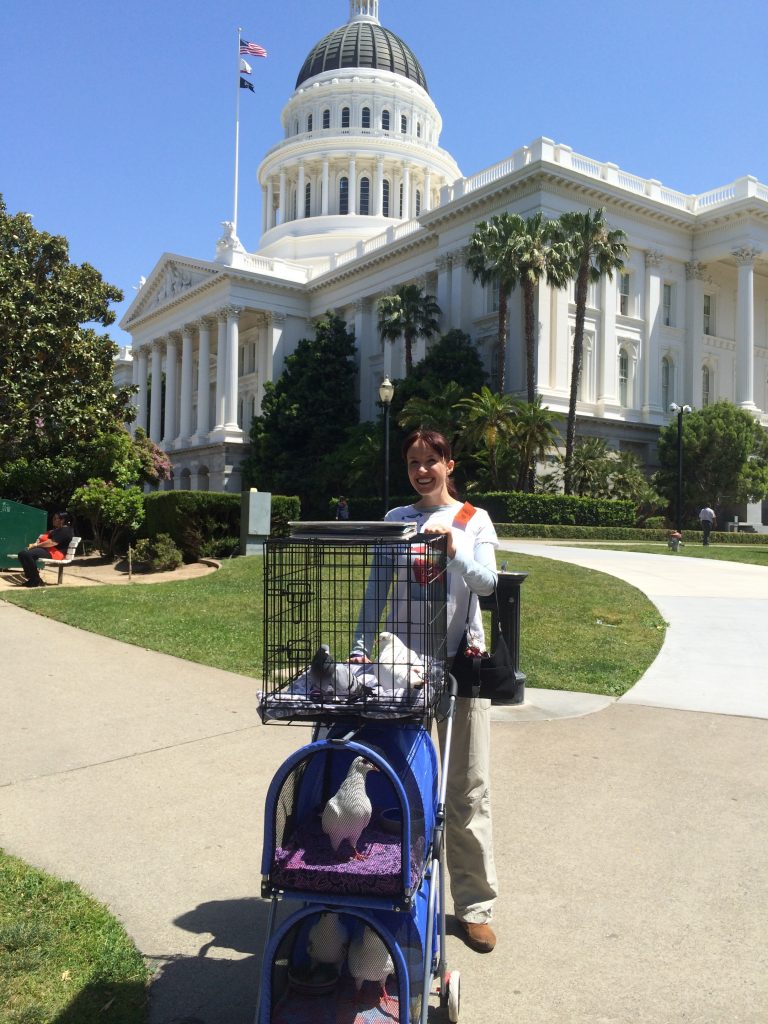
Christiana bringing Palomacy to the Capitol
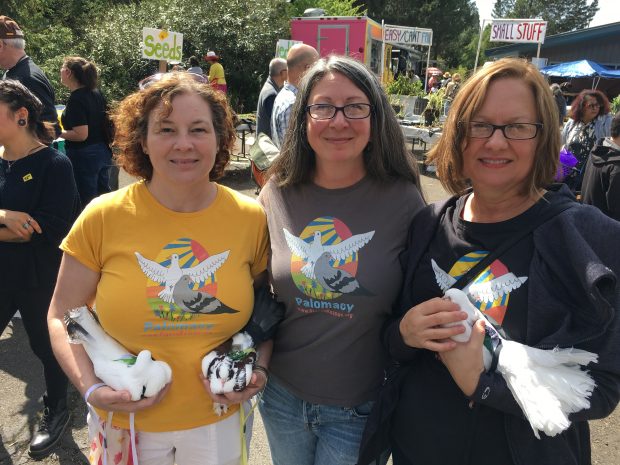
Ellie, Elizabeth & Jill outreaching at the Oakland Plant Exchange
Event Planning Volunteers
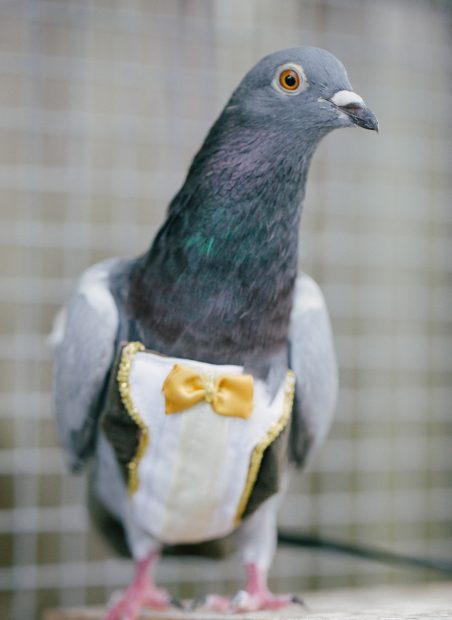
Pigeons love to party (Coo Jackman photo by Elisabeth Millay)
2017 is our tenth anniversary and we need to organize a wonderful get together in celebration of all that we are doing!
Special Project Volunteers
Create a new Palomacy video (3 minutes)
Update & Redo Online Forms (from VFB Pro to Formstack or ?)
Set up Palomacy Email Group (Dadamail or ?)
Upgrade Contacts Database (Donors, Volunteers, Newsletter subscribers)
Foster Volunteers
You can enjoy birds & help save the lives of pigeons & doves even if you can’t adopt!
Animal Assisted Therapy Volunteers
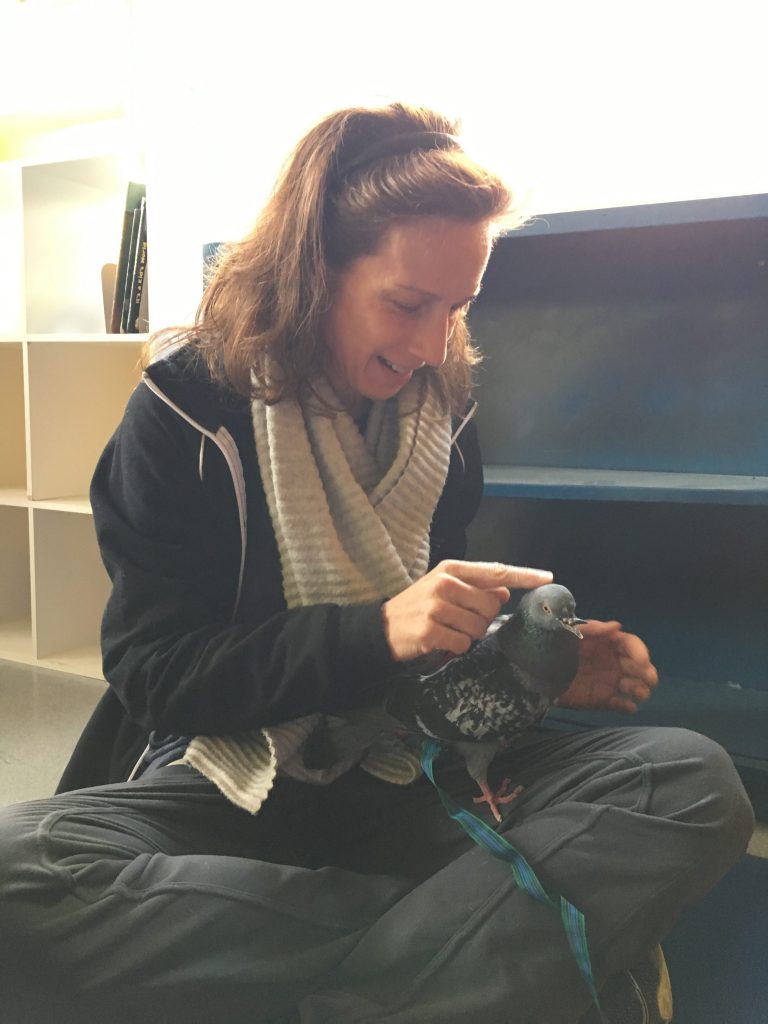
Christina Chavez (SF SPCA Animal Assisted Therapy Program) & Prince
We are currently recruiting volunteers with one or more pigeons (adopted or fostered) to join us in our participation with the SF SPCA’s Animal Assisted Therapy Program. (Volunteer opportunities are located in SF, vet check certificate and additional training required.)
For any of the above (and there are lots more ways to help too), please complete our online application or contact Elizabeth if you have questions.
Thank you!
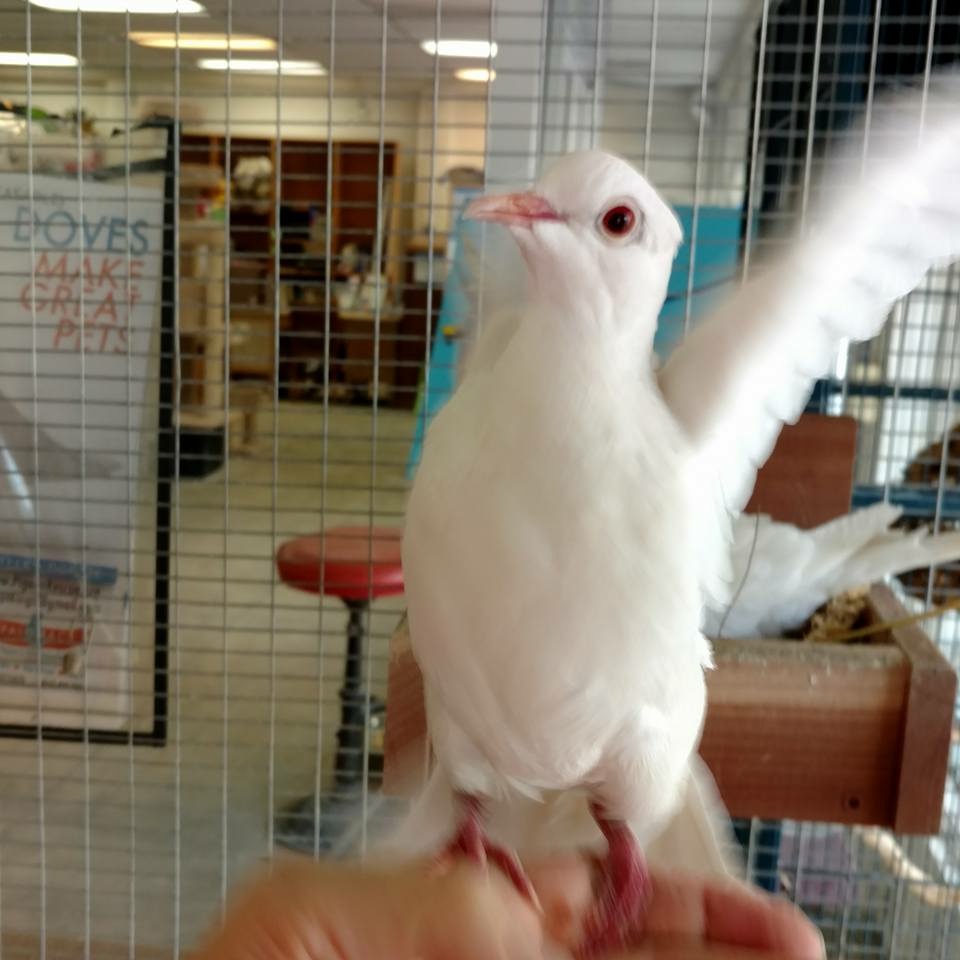
Thank you for helping Palomacy help birds!
March 24, 2017
by Elizabeth
Comments Off on Rescued King Pigeon Kids Patch, Alfred & Bert
Rescued King Pigeon Kids Patch, Alfred & Bert
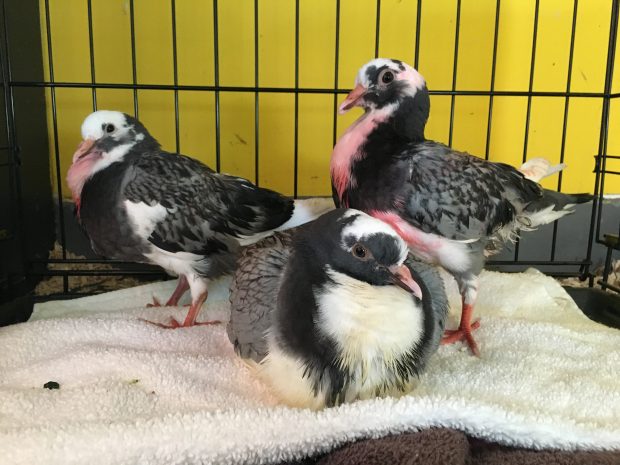
Rescued King pigeon youngsters Alfred & Bert (dyed pink) & Patch
One million domestic King pigeons are bred annually in California for meat (squab). A few wind up in rescue rather than as the dinner on a fancy plate they were intended to be. With your support, Palomacy helps these and other lucky survivors get adopted rather than euthanized. With your help, we are closing a deadly gap in the animal welfare community. Every one of these birds is an individual. Here’s the story of three: Patch, Alfred and Bert.
Instead of being butchered when they were four weeks old, Patch, Alfred and Bert were purchased live from a poultry market. We don’t know how many were “released” (either in a misguided effort to liberate them or for ceremonial use) but we do know how many were rescued- three.
The Good Samaritan who found the three baby pigeons huddled together in a park on June 20th, 2016, knew they were out of place and so he gathered them up and brought them to the San Francisco SPCA. Though they don’t usually take in birds, their Humane Education team, already fostering four of Palomacy’s pigeons in the Summer Camp program, made an exception for them.
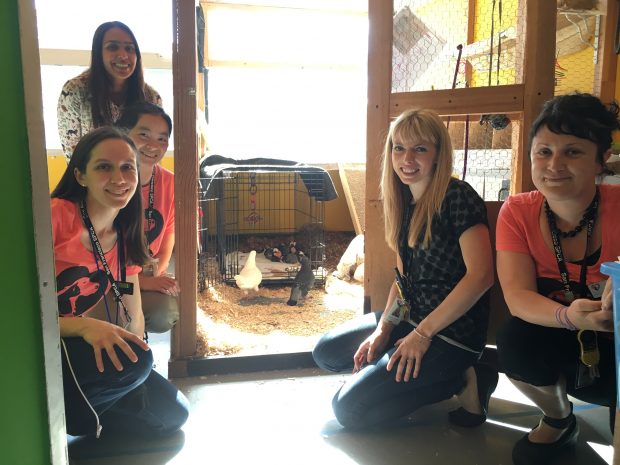
SF SPCA Humane Educators rescued Patch, Alfred & Bert
All of our foster homes and aviaries were full up (we always are with usually 120+ pigeons and doves in our care plus a waiting list) and so the extra help from the Humane Ed team was critical. I went to check on the pigeon youngsters that afternoon and they were sick. While adult pigeons are hardy, the youngsters, their immune systems undeveloped and exposed to so much stress through the “harvesting”, transport and sales/”release” process, are frail. We got them settled in and started on antibiotics. They had eluded the butcher and survived an inhumane “release”. They were very lucky to be alive.
Everyone fell in love with the strikingly marked black and white pigeons. As if they weren’t eye-catching enough, Alfred and Bert’s feathers were stained with pink food coloring- something that the poultry sellers do to mark batches of birds. Unfortunately, despite all the loving care of the SF SPCA team and the best efforts of our avian vets at Medical Center for Birds, Patch, the sickest of the trio, passed away on July 11th. Necropsy revealed the extent of his infection which affected multiple organs as well as the lack of immune response.
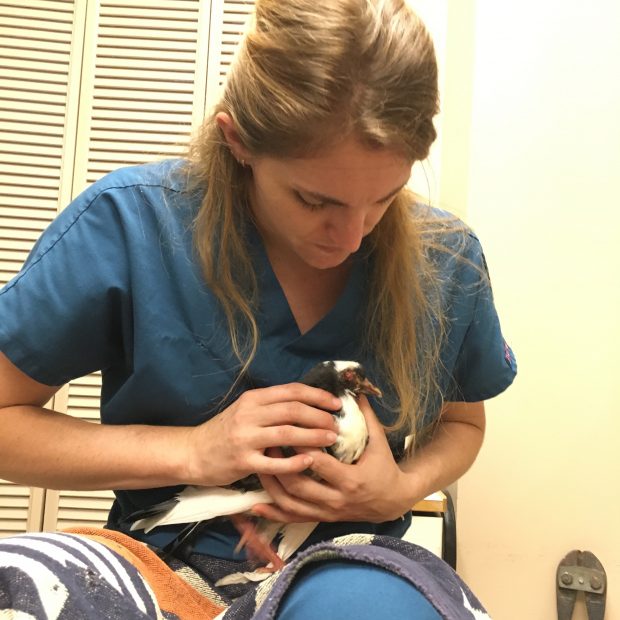
Dr. Murphy taking care of Patch
Time went on and Alfred and Bert grew to maturity. The four adult pigeons fostered in the aviary with them, Rose and José and Hannah and Oakley, had been tolerant of them as youngsters but as puberty set in, tensions arose with the flock. Bert who had been a confident and bossy bird (despite his crossed beak) began to get bullied and to decline. He lost weight, needed to be separated from the flock and required repeated vet visits to treat multiple issues. Maggie Amiano, Humane Education Department Manager, went so above and beyond helping to not only care for and transport Bert many miles back and forth to vet visits but also contributing very generously towards his considerable vet expenses. Maggie writes,
“Having the chance to rescue the baby pigeons last summer had just as much effect on my staff and me as is did the pigeons. They had a new chance at life, but we gained the chance to teach nearly 1000 kids about kindness, empathy, and compassion for living things- especially when they need it most. Our camp counselors, campers, and volunteers bonded with these wonderful birds, and we are still continually talking about Alfred’s updates on Instagram. We were truly the lucky ones!”
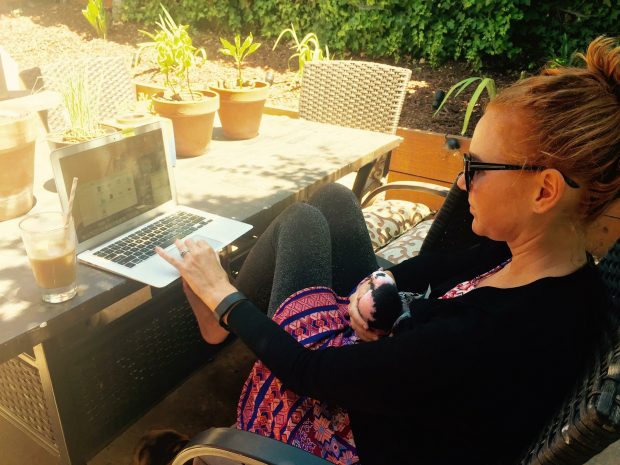
Maggie & Bert working from home together
Eventually, I took Bert into my foster care for additional support with his medical issues and Alfred went to try living with a pair of Palomacy supporters, Aria and Julie, who had gone to the trouble and expense of moving out of their apartment and into another just so they could adopt a pet pigeon.
For Alfred and Aria and Julie, it was love right from the start! Alfred is home, adopted. She (yes, she we now know) really blossomed in their care and Alfred is one of the happiest, most beautiful pigeons ever! She loves her people and all the ways they dote on her including giving her free range of their apartment, minced veggies and fresh greens, on-demand sink showers, a special cozy after-bath lounge, coconut oil foot rubs, all the charger cords she can steal for nest-building, etc. etc.
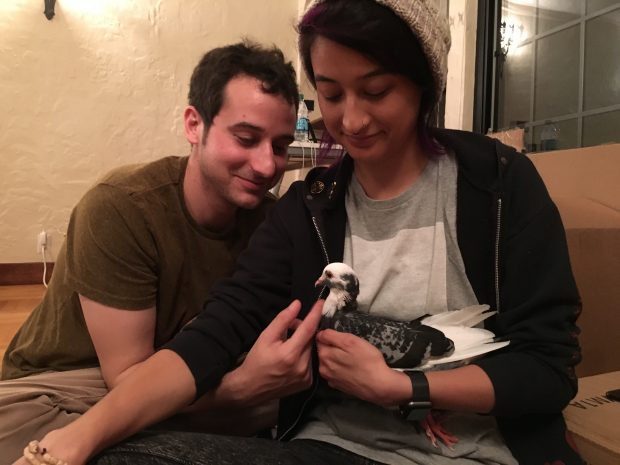
Aria & Julie & Alfred fell madly in love
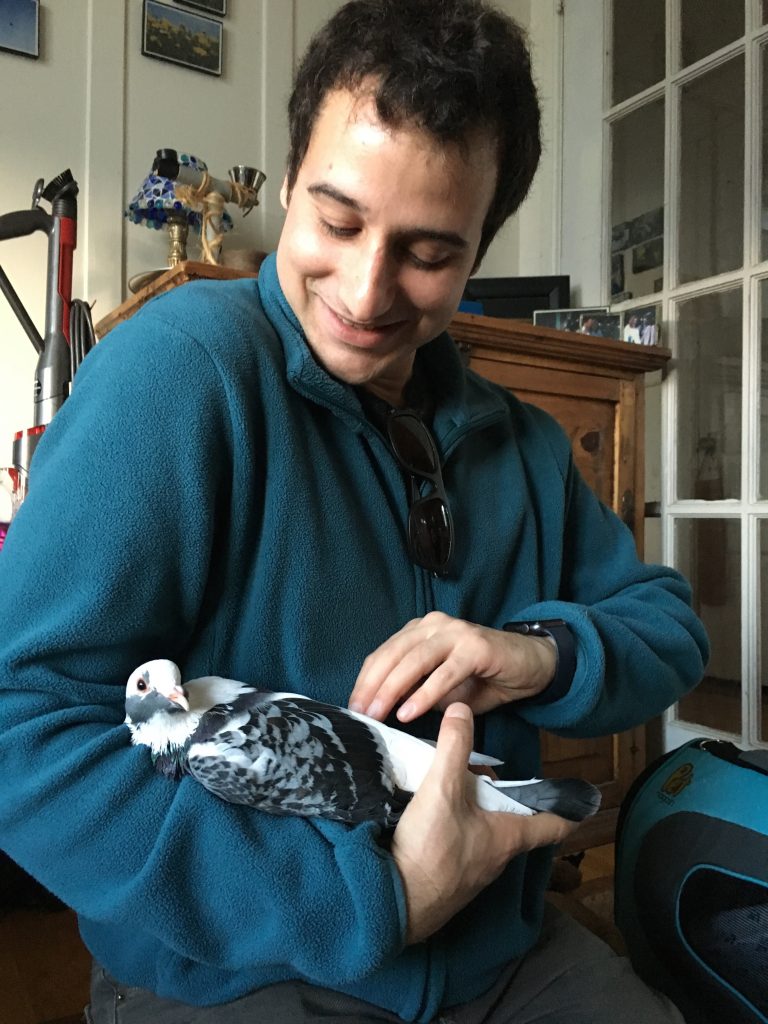
Alfred’s pretty comfortable with how everything’s working out
Alfred even has her own awesome Instagram account and now she has a mate too- a very lucky and charming unreleasable Rock pigeon named Pirate has joined the family!
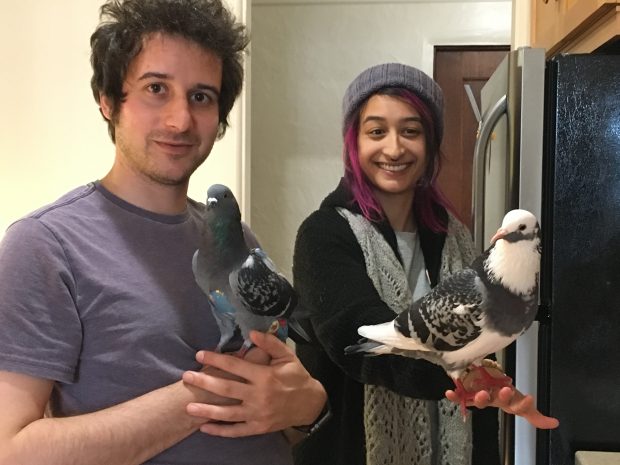
Aria & Pirate & Julie & Alfred
Aria writes, “I never thought a pet pigeon could be like this – of course I have always thought they were funny and cute but it was not until actually spending time with Alfred that I realized how incredibly complex and emotional of an animal a pigeon is. She tells me so much just through her eyes, gestures and actions. I think many people would be shocked – I know my friends were – to find out a pigeon is much more like a cat or dog than a passive pet. She lands on my head, she gives me kisses, she sits with me for long periods. She tells me when she wants sticks or food. The companionship is amazing and it’s nearly impossible not to fall in love once this is discovered. I could not be happier – happier than I thought we would be. Yes it feels amazing to rescue this amazing girl and give her a wonderful life, but even for myself – the joy I get from seeing here everyday is unquantifiable. One of the best decisions I ever made.”
Bert is still fostered with me, still getting eye drops every day in order to defeat the persistent pseudamonis sinus infection once and for all. He is a very handsome and loveable bird, no longer pink but forever with his crossed beak. I’ve been told by more than a few people that he is their favorite.
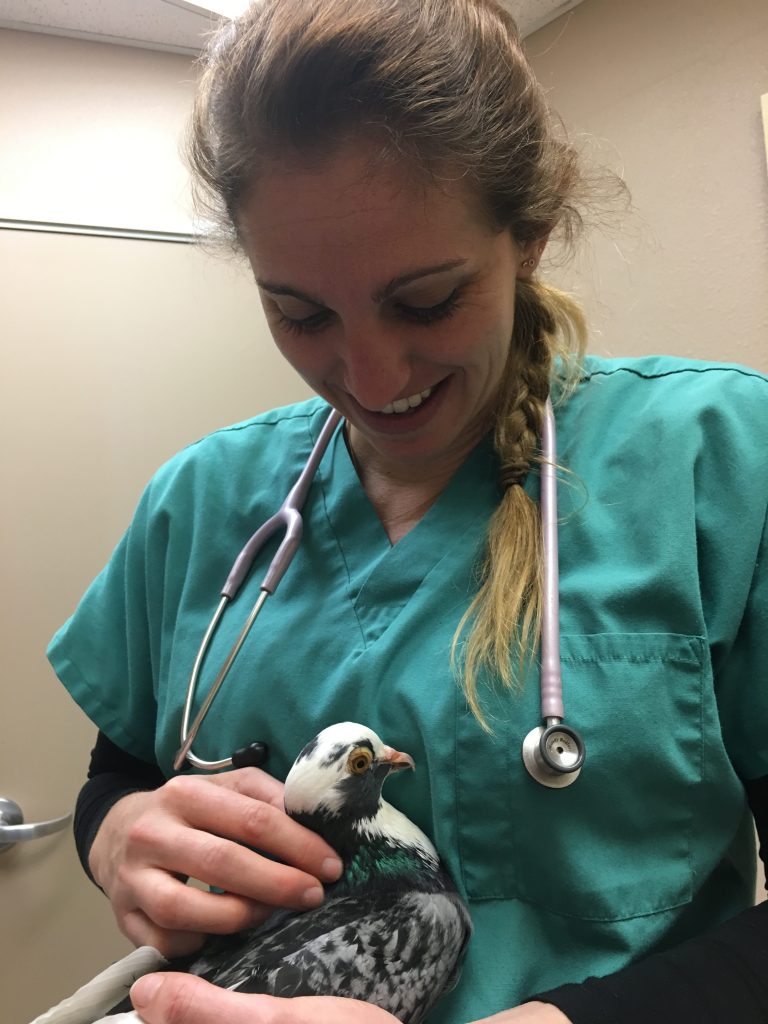
Dr. Bianca Murphy loves Bert (and visa versa)
Bert’s a great ambassador and lots of fun to take to outreach events. Bert has come a long very way from the squab plant where he was bred to be meat. Bert’s ready to romance a lady pigeon, to be adopted, to go home. Are you ready for Bert?
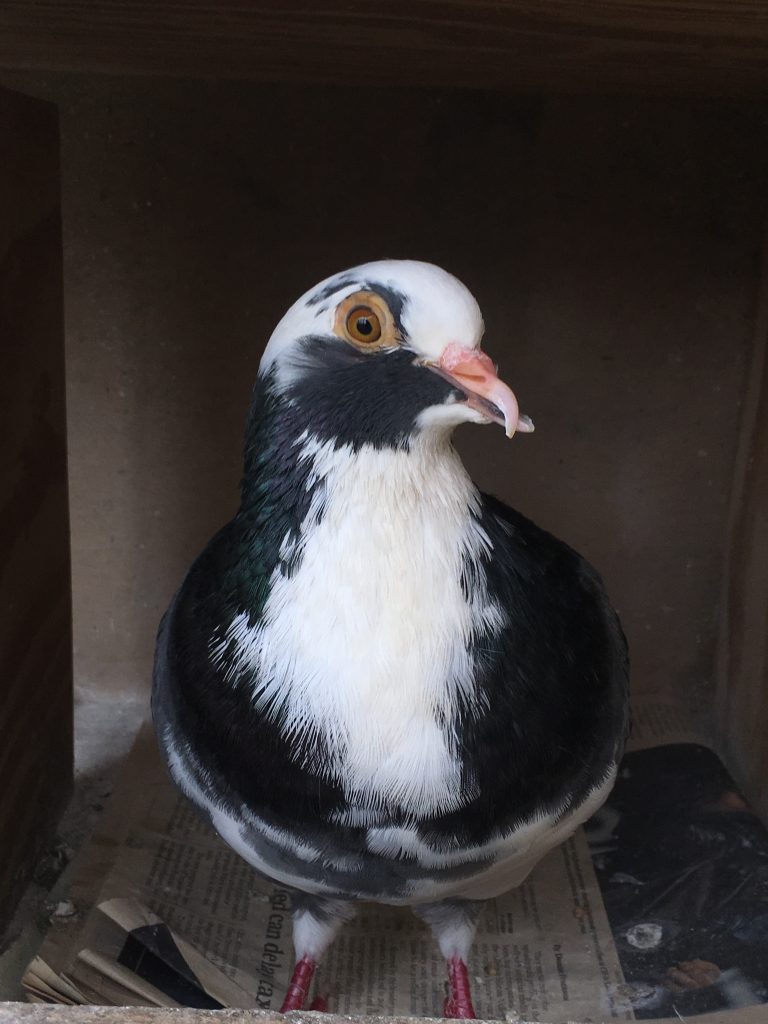
Bert says Thank You for helping pigeons like him
Please sign and share our pledge to not eat squab
Learn more about King pigeons and how they wind up needing rescue
March 17, 2017
by Elizabeth
Comments Off on Thank You Craig Newmark & craigslist Charitable Fund!
Thank You Craig Newmark & craigslist Charitable Fund!
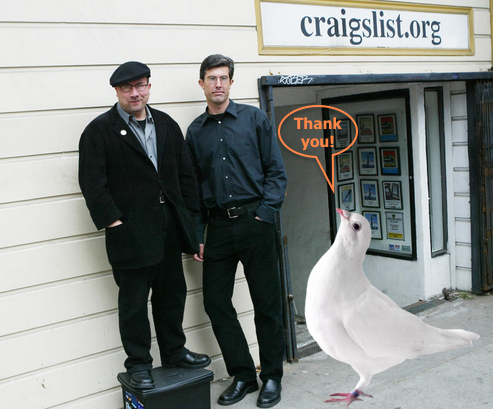
Thank you Craig & Jim & craigslist Charitable Fund!
Since pigeons don’t have pockets, they don’t have money and so, to rescue them, Palomacy has to inspire so much generosity in so many people! Thanks to two especially supportive donors, Craig Newmark (founder of craigslist) and the craigslist Charitable Fund (led by craigslist CEO Jim Buckmaster) and their two incredibly important $10,000 donations in support of our work, we are able to continue leading this compassion for all movement we call Palomacy.
I cannot tell you how grateful I am for these generous gifts. Every dollar donated is one less that we have to spend time and energy seeking and these twenty thousand dollars will help us save a great many lives.
There are so many birds in need of our advocacy, so many shelters and sanctuaries that need our partnership, so many adoptions to accomplish, so many exploitive and cruel practices to expose and oppose…
We know that what we are doing is making a difference! We see every day the benefits kindness, compassion and mercy bestow, not only for the recipients but for those who give them. (See the stories here.)
In 2016, twenty six Palomacy fosters cared for 336 rescued birds! These volunteers, located from San Jose to Sacramento and everywhere in between, cared for the birds every day, fed them, cleaned up after them, transported them, healed them, promoted them, publicized them, helped 199 to get home! Palomacy also helps many wild birds find their way safely to amazing rescues like WildCare and the Wildlife Center of Silicon Valley. And we help lots of birds all over the country and beyond with coaching, referring and support.
Our supporters and volunteers and partners are extremely generous! And we are very, very frugal! Even so, it cost Palomacy $101,426 to do what we did in 2016. That’s not a lot for some rescues. Some raise $100K in one event! But we aren’t there yet and it takes everything we have to do what we do and raise what we need. Your ongoing support is incredibly important to us. (Read more about Craig’s support for Palomacy here.)
Thank you, Craig and craigslist Charitable Fund for investing so kindheartedly in the work that we are doing. Your support is profoundly appreciated!
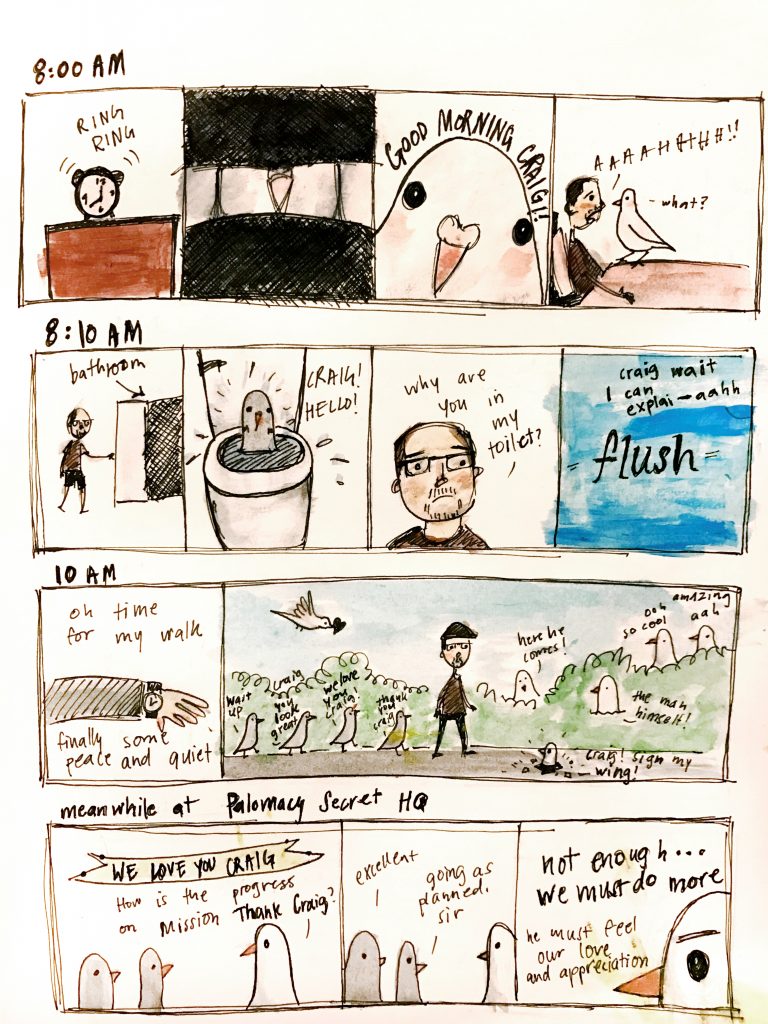
Palomacy Mission Thank Craig
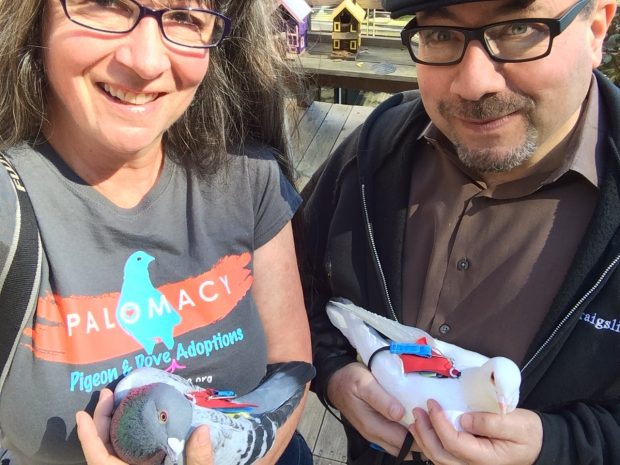
Palomacy Loves Craig & craigslist Charitable Fund!
March 16, 2017
by Elizabeth
Comments Off on Lois & Alice
Lois & Alice
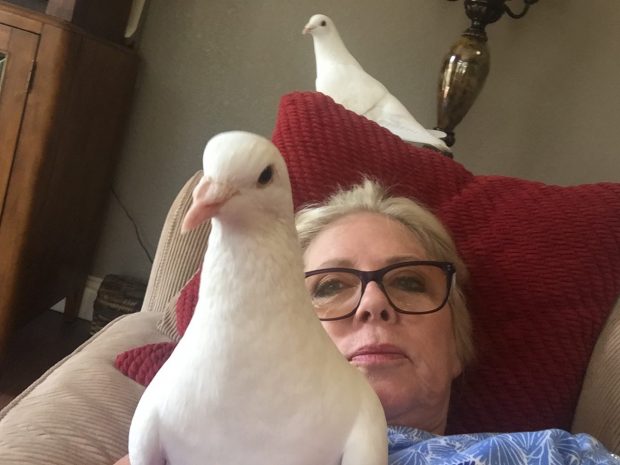
Guest Post by Lynn Eaton
I have never been a bird person. Period. When I was a newly-wed a hundred years ago, my then husband brought home a Quaker parrot. It was a hate/hate relationship that lasted about two months before I insisted it be brought back to where it came from. Never understood how anyone could have these flighty, pecky, noisy, messy, and destructive little creatures in their homes. And I’m talking about birds not men. Although…
A few decades later, I currently have two indoor rescue pigeons that I would fall on a sword for. And it happened quickly. Almost like there was plan in place to shake me out of my coma-like existence when it came to pets.
A little over a year ago, I was very content with my two pedigree elderly Ragdoll cats. Enter Janice, a co-worker at a newspaper office I worked at in Malibu. Under “bunny-hugger”, there is a photo of Janice. She only worked at the paper a few hours a week and sweetly asked if I would mind assisting in the care of a “white dove” she found. She had received approval from the owner of the paper to keep this “dove” at our work place. She made it sound fun! We could have a contest at work coming up with a name! Keep it in the accounting department and listen to it coo softly all day! On and on and on.
Janice had found Lois Lane (contest winner name) stranded and unable to fly in an area of Malibu that is very tranquil and apparently, a perfect place for celebrations and dove releases. She gathered up the “dove” and took it immediately to the wildlife center where they promptly put it in with some chickens. This niggled at Janice for several days and after gaining approval to keep the bird at work, she re-rescued Lois (for which the Center hilariously charged her) and brought her into the office.
In short order, I realized Janice nor I knew almost nothing about the care and feeding of this bird. We had a cage, some seeds and water and this pretty little bird that didn’t so much as make a peep. I’m not certain when I came across Palomacy, but I’m almost sure it was on that first day. I was totally panicked. Elizabeth was the first and ONLY person to return my frantic calls.
Elizabeth calmly told me what to do and after describing what the bird looked like, burst my bubble by informing me that what we had was a pigeon. A “homer” at that. I fought that tooth and nail. I did not want a mere pigeon, I wanted a sweet-cooing dove. The Peace & Love and married for life kind of dove. It took me weeks and tons of research to realize yes, Lois is a homer. Not even a King. A homer. Dumb name. As in “Homer Simpson”. I didn’t realize that homer meant HOMING PIGEON.
Poor Elizabeth was then my new best friend and I called frequently. Everything made me a nervous wreck. Was the cage big enough? How much should we feed her? Doesn’t she need another pigeon friend? Is it acceptable to leave her ALL ALONE ON WEEKENDS???? It didn’t help that Lois was going through a soft molt.
This went on for a few months and during that time Lois really was the calmest, quietest bird. So bomb-proof. We moved her cage around the office several times to find better locations, were constantly buying new and improved cage stuff (dishes, toys, mirrors and nesting thingys) and just futzing in general with her environment.
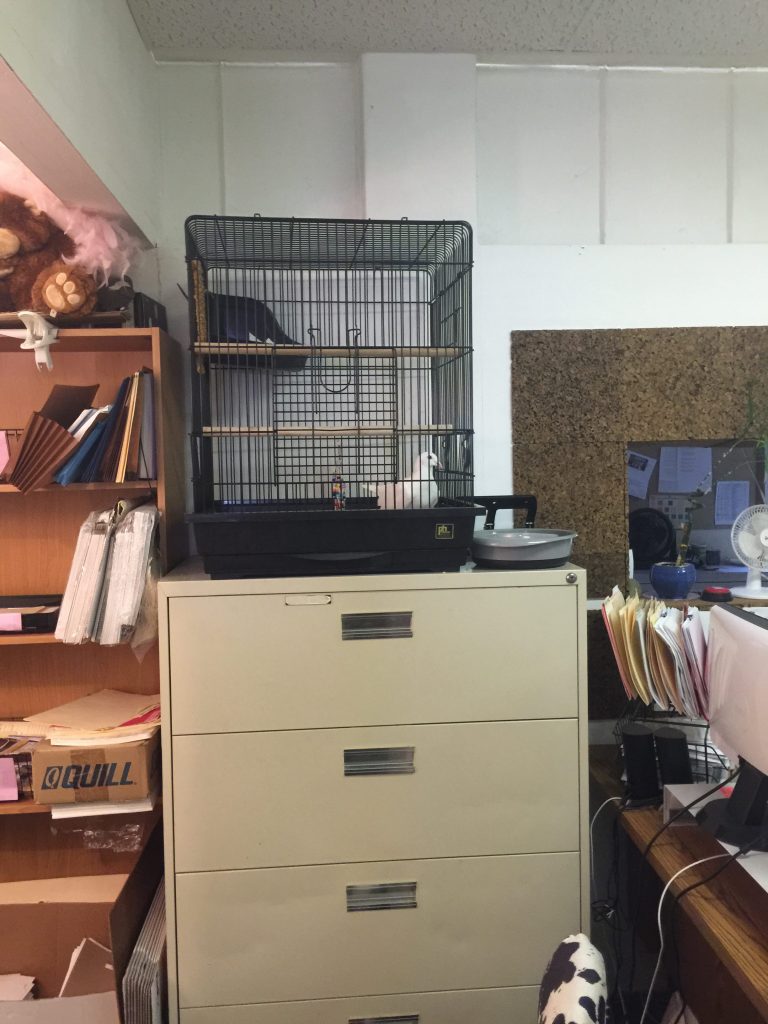
Lois at the office
In my on-going research and constant conversations with Elizabeth, I determined that Lois needed to spend time outside in the sunshine and fresh air. Lois just seemed so complacent; not unhappy but resigned. I was very twitter-pated about this. So, I purchased an Easy Up. Which is basically a big enclosed play pen for camping. Not predator proof AT ALL but we made do. Lois now got to go outside every day. I was happy. For a few weeks.
It’s hard to believe but we rarely if at all touched this bird. We would move her cage from the office to the easy up outside, open the cage door, put a large bowl of water for her to bathe in and then take her back in at the end of the day. Janice and I were pushing hard to rescue another pigeon friend for her as she was left alone so much – especially on the weekends. We were met with a lot of resistance from the staff. We literally did not have the room in the office for a larger cage and building an outdoor aviary was not going to happen as it took tons of begging and cajoling to even erect the Easy Up outside our office space.
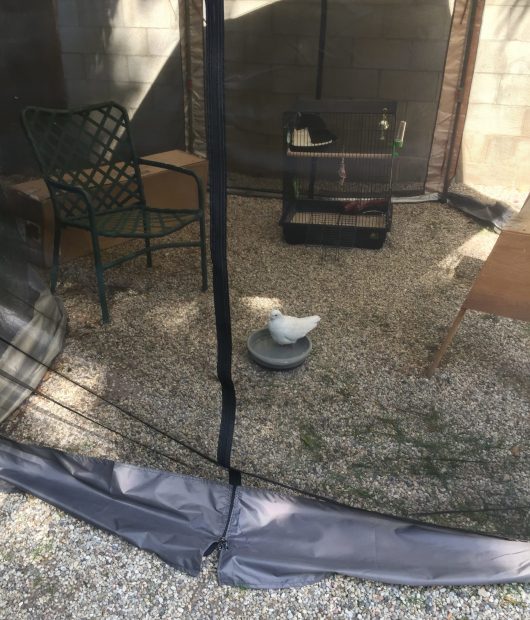
Lois bathing in the Easy Up
Around this time, I decided to finally move closer to my children in Tehachapi CA. A small mountain community 175 miles north of Malibu. As I was giving notice, I burst into tears and emphatically stated “AND I’M TAKING LOIS WITH ME”!!! Like a 5-year-old. I still can’t believe those words came out of my mouth. I was met with no resistance – more like, THANK GOD. Can we help you pack up and put the bird in the car for you? Humph!
Very quickly, I moved and installed Lois in my home where she has a Rolls Royce of a cage that she resides in only at bedtime, poops on organic bird cage paper and can fly up to specifically installed corner perches in my office/indoor aviary all day and every day.
Now it was time to adopt her a buddy! With the assistance, once again of Elizabeth, I adopted sweet, sweet Alice from Palomacy. (We each drove a couple hours and met in Fresno.) Yes, another female homing pigeon. Suffice it to say, there was a brief period of time where I was convinced Lois was a male – even renamed her Lincoln. Unfortunately, that brief period of time coincided at the exact same time I was adopting Alice. Hence, the two females. It’s not perfect but we make it work. I’m the official mate of both these girls.
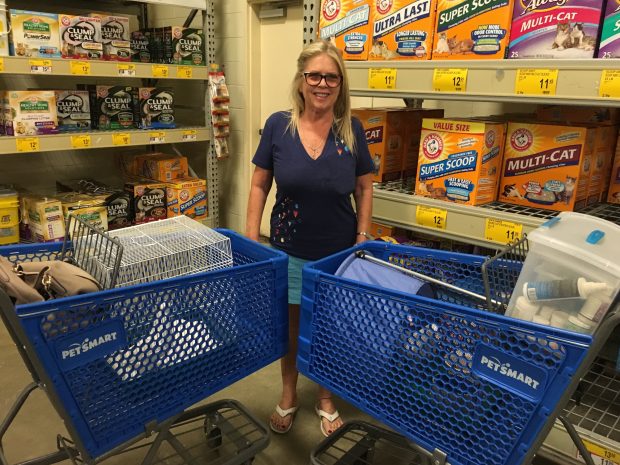
L-R: Lois, Lynn, Alice
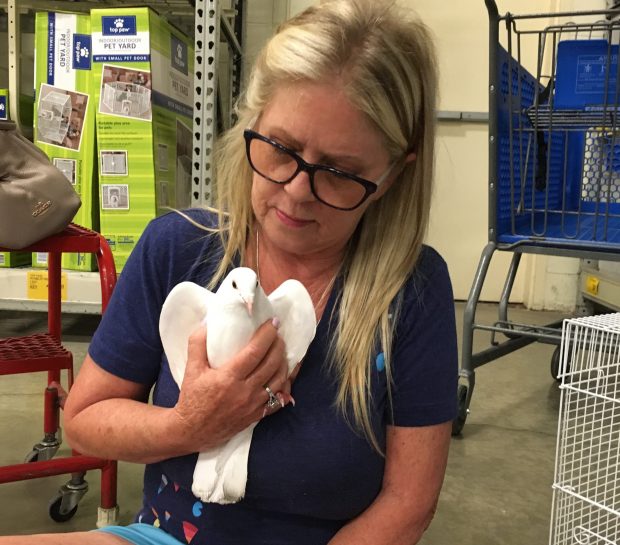
Lynn and her clever self-rescuer Super Lois
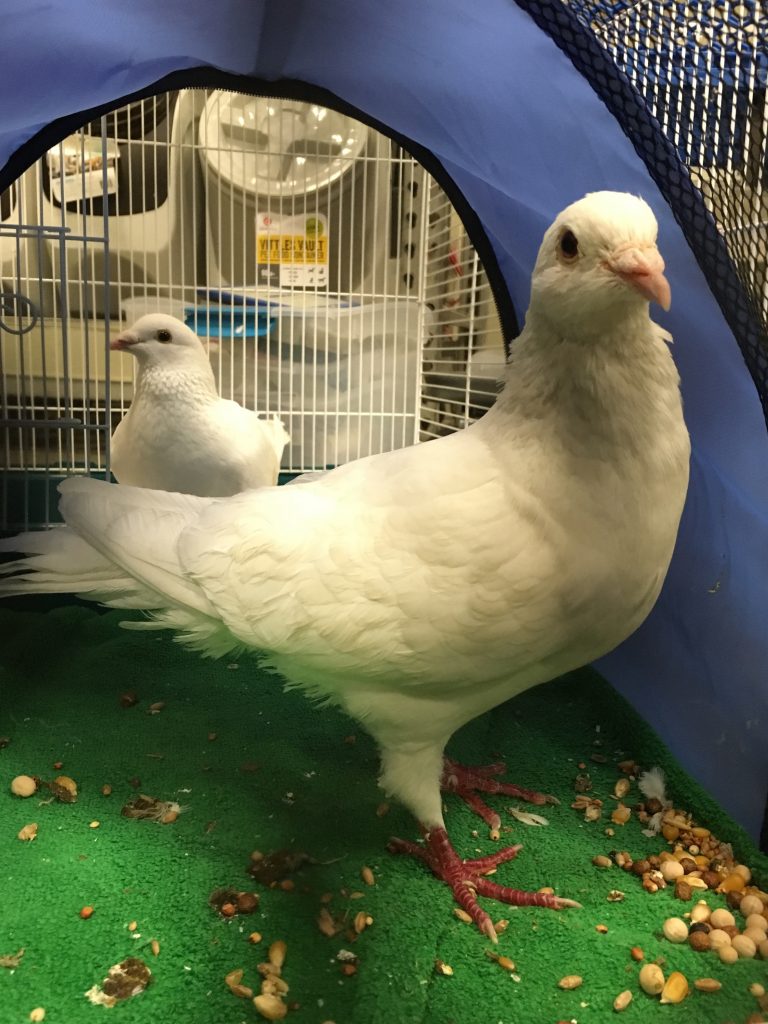
Lois & Alice meet
Thank you, Elizabeth, Palomacy and all the pigeon/dove rescuers out there. I read every single post you guys make and have learned so much this last year. My ignorance of pigeons and birds in general proves how wrong I was and how truly adaptable these guys are. They fumble right along with you while you’re learning and never complain. That does not stop me from continuously trying to make their habitat fun and entertaining. I love the phrase: You will not save the world by adopting a pigeon, but you will save that pigeon’s world.
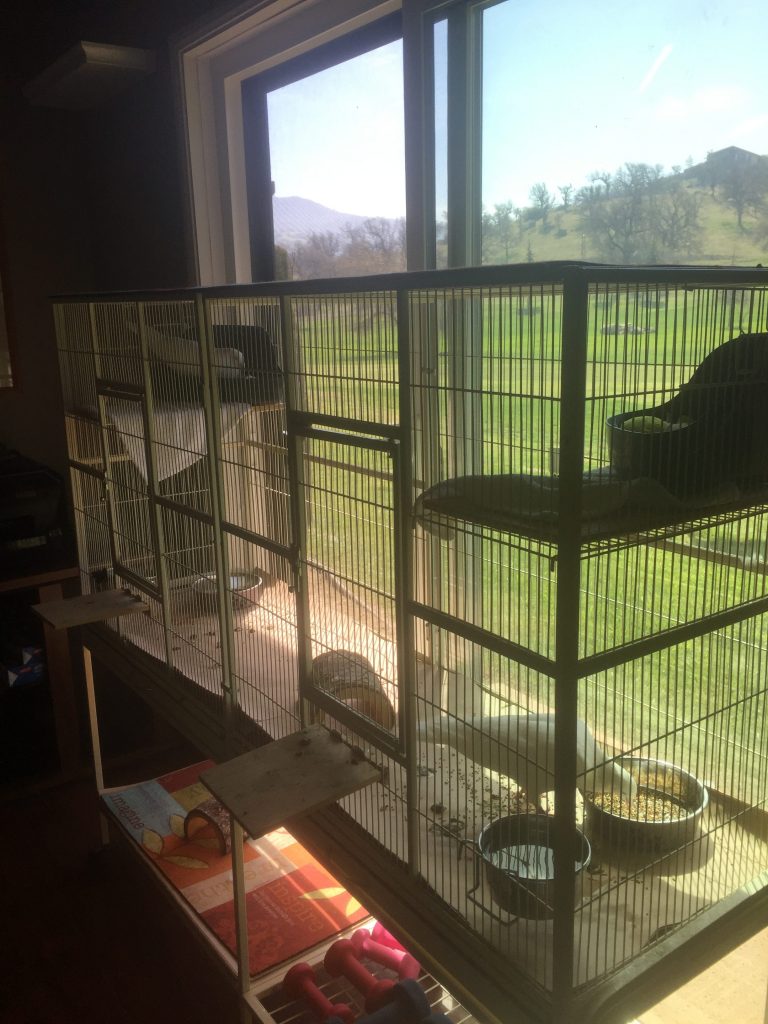
Lois & Alice share a double-flight cage & Lynn’s office
In conclusion, these sweet little misunderstood birds have changed my life for the better. There is not a day that goes by that I don’t laugh out loud at them. I love them, love them, love them.
Now if I could just find a male that could take on two females…
Rescued pigeon Lois, wearing pigeon pants for the first time, leads Lynn around for a stroll. (Please note that pigeons are very vulnerable and shouldn’t be walked in unsafe locations where they could be attacked by a playful dog or hungry hawk. Pigeon pants are diapers and can’t be trusted as a safety harness. Pet pigeons have been startled and busted right out of their pants. You can learn more about pigeon pants at here.)
 Lynn retired from a 35-year Mortgage Banking career and begin enjoying life from the moment she quit smoking, drinking and finalized the sale of her company in 2012. She took on a very fun clerical position at The Malibu Times for a brief period but more importantly was introduced to the rescue pigeon Lois.
Lynn retired from a 35-year Mortgage Banking career and begin enjoying life from the moment she quit smoking, drinking and finalized the sale of her company in 2012. She took on a very fun clerical position at The Malibu Times for a brief period but more importantly was introduced to the rescue pigeon Lois.
She lived in Malibu for 30 years before moving, snatching up Lois and high-tailing it to rural Tehachapi to be closer to her grandchildren.
She now resides in condo on a very remote golf course and is spending most days checking out the wildlife or as she says, “living the dream smack in the middle of a Walt Disney movie set.”
She pinches herself daily.


